Category
New Additions
50 entries in this category | view all categories
Oh, Dear, My Thanksgiving Dinner!
Posted November 2015 in New Additions, Publishing
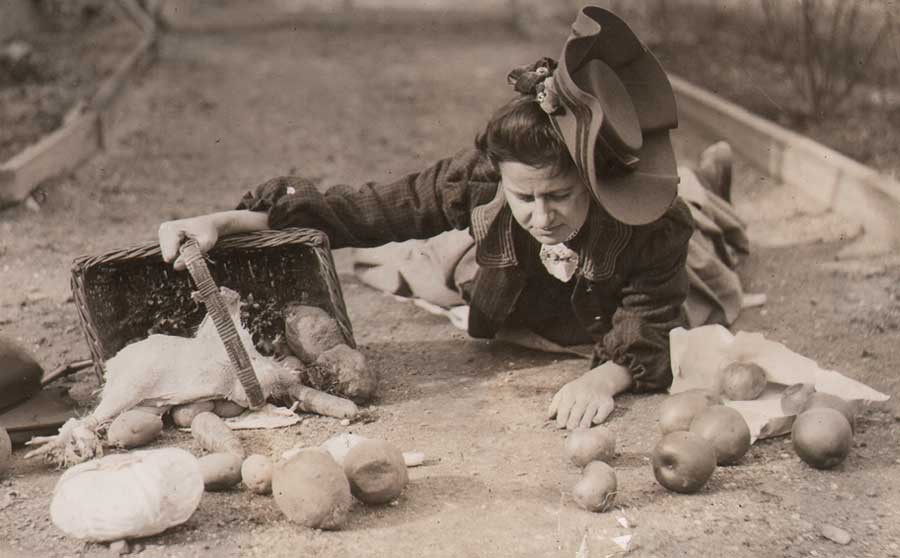 Detail: "Oh, Dear, My Thanksgiving Dinner!" c. 1907 by Jeanette Bernard: American, born Germany: (1855-1941) gelatin silver print c. 1935-40 from original glass plate negative acquired by Culver Service : 15.6 x 20.0 cm: from PhotoSeed Archive
Detail: "Oh, Dear, My Thanksgiving Dinner!" c. 1907 by Jeanette Bernard: American, born Germany: (1855-1941) gelatin silver print c. 1935-40 from original glass plate negative acquired by Culver Service : 15.6 x 20.0 cm: from PhotoSeed Archive
A Happy 4th to All
Posted July 2015 in Childhood Photography, New Additions
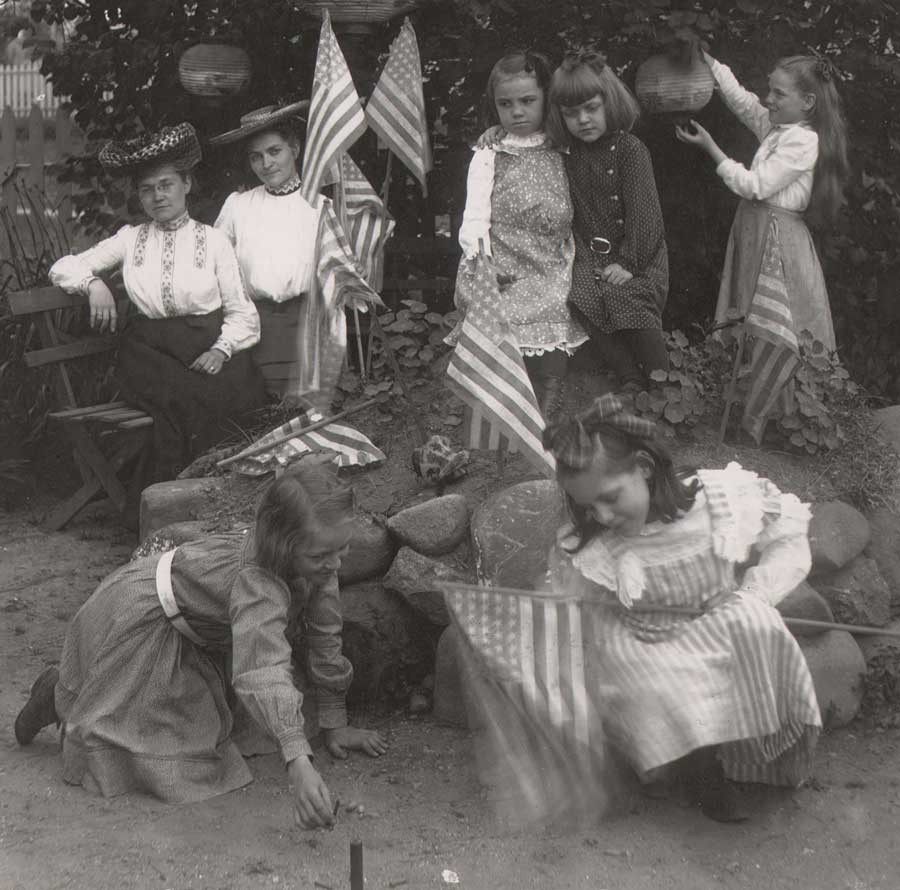 Detail: "4th of July", c. 1905 by Jeanette Bernard: American, born Germany: (1855-1941) gelatin silver print c. 1935-40 from original glass plate negative acquired by Culver Service : 18.7 x 16.1 cm: from PhotoSeed Archive
Detail: "4th of July", c. 1905 by Jeanette Bernard: American, born Germany: (1855-1941) gelatin silver print c. 1935-40 from original glass plate negative acquired by Culver Service : 18.7 x 16.1 cm: from PhotoSeed Archive
The Idea of Hawaii
Posted April 2015 in History of Photography, New Additions, Typography
In the public consciousness at least, Hawaii has probably not changed too much in the past 100 years. By this I mean an island chain of magnificent tropical beauty, mystery, and earthly delights with a strong emphasis on the natural world being the preferred vision for this place for many of us; with the realities of crime, squalor and all the other maladies undoubtedly present on some scale cast aside for the sake of bliss. You see, in this chaotic world, people need and want to believe utopia by the name Hawaii must exist.
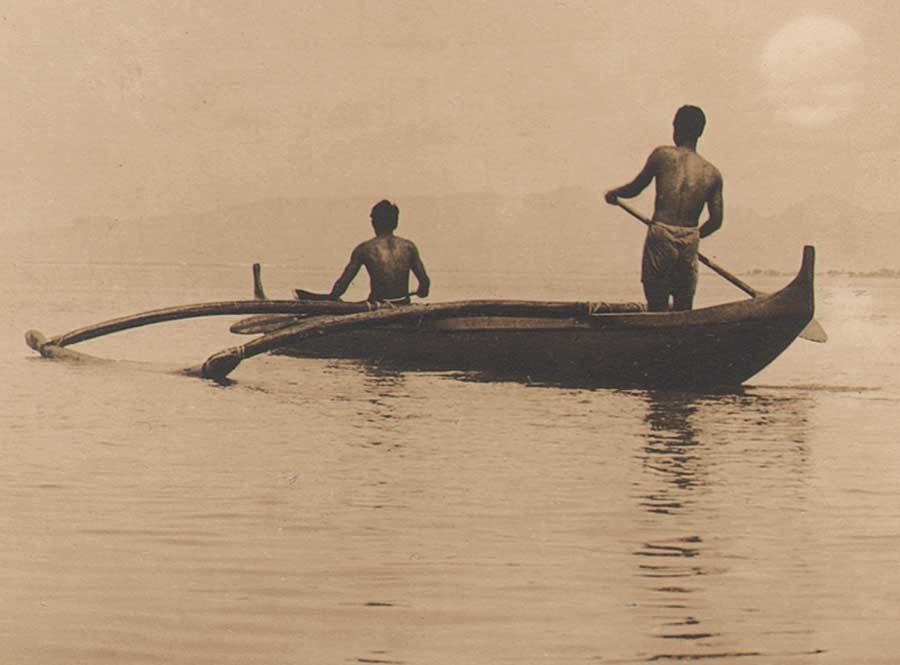 Detail: A.R. Gurrey Jr., American: "In measured tones subdued and low…" ca. 1910-20: vintage gelatin silver print from leaf included in volume "Idyls of Hawaii" (10.2 x 11.6 | 25.0 x 19.8 cm) Native Hawaiians are seen steering an outrigger canoe, possibly on Kaneohe Bay off the coast of Oʻahu. : From: PhotoSeed Archive
Detail: A.R. Gurrey Jr., American: "In measured tones subdued and low…" ca. 1910-20: vintage gelatin silver print from leaf included in volume "Idyls of Hawaii" (10.2 x 11.6 | 25.0 x 19.8 cm) Native Hawaiians are seen steering an outrigger canoe, possibly on Kaneohe Bay off the coast of Oʻahu. : From: PhotoSeed Archive
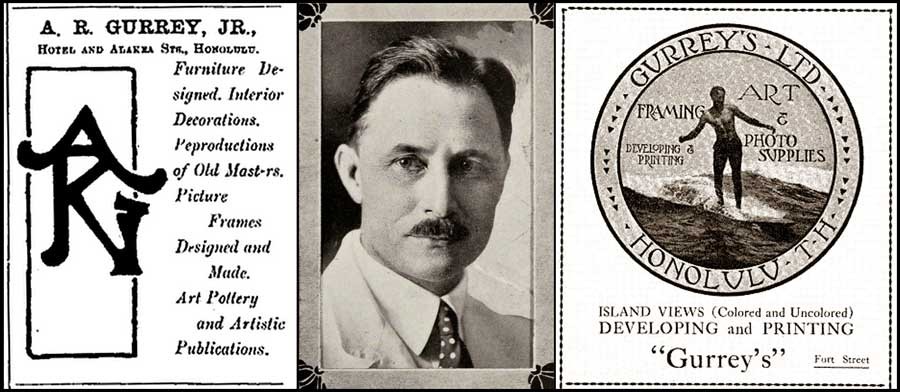 Left: first published version of A.R. Gurrey Jr. monogram from 1902 advertisement for his Honolulu store from "The Friend" magazine of that city. Middle: portrait of Gurrey Jr. published in "Men of Hawaii" from 1917. His WWI draft registration from 1918 listed his occupation as art dealer with his physical features being short, of medium build with gray eyes and brown hair. He lived with wife Caroline Haskins Gurrey, an accomplished portrait photographer, at 2512 Upper Manoa in Honolulu. Right: this circular logo for Gurrey's Ltd. located at 1066 Fort St. in Honolulu featured Duke Paoa Kahanamoku riding a surfboard. Open from late 1909 to 1923, the shop in a 1912 mention in Mid-Pacific magazine stated: "This Art and Photo Shop is the home of the Hawaiian Roycroftes, where you can see the work of the leading artists of the Islands, small views, native types and surfriders and other objects of art. Besides being the leading art shop, they are agents for the Ansco Cameras and Cyko Paper, with a developing and printing department that cannot be excelled." all images from: Hathi Trust.
Left: first published version of A.R. Gurrey Jr. monogram from 1902 advertisement for his Honolulu store from "The Friend" magazine of that city. Middle: portrait of Gurrey Jr. published in "Men of Hawaii" from 1917. His WWI draft registration from 1918 listed his occupation as art dealer with his physical features being short, of medium build with gray eyes and brown hair. He lived with wife Caroline Haskins Gurrey, an accomplished portrait photographer, at 2512 Upper Manoa in Honolulu. Right: this circular logo for Gurrey's Ltd. located at 1066 Fort St. in Honolulu featured Duke Paoa Kahanamoku riding a surfboard. Open from late 1909 to 1923, the shop in a 1912 mention in Mid-Pacific magazine stated: "This Art and Photo Shop is the home of the Hawaiian Roycroftes, where you can see the work of the leading artists of the Islands, small views, native types and surfriders and other objects of art. Besides being the leading art shop, they are agents for the Ansco Cameras and Cyko Paper, with a developing and printing department that cannot be excelled." all images from: Hathi Trust.
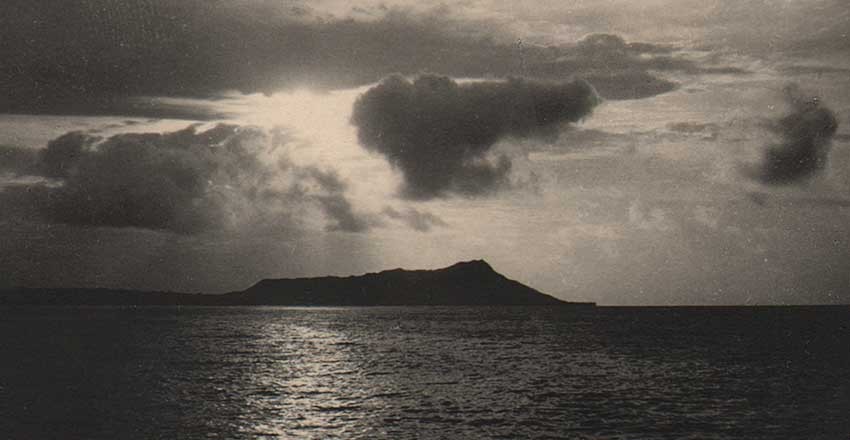 Detail: A.R. Gurrey Jr., American: "Old ocean singing a psalm of delight…" (ocean view of Diamond Head in silhouette) ca. 1910-20: vintage gelatin silver print from leaf included in volume "Idyls of Hawaii" (7.8 x 11.5 | 25.0 x 19.8 cm) : From: PhotoSeed Archive
Detail: A.R. Gurrey Jr., American: "Old ocean singing a psalm of delight…" (ocean view of Diamond Head in silhouette) ca. 1910-20: vintage gelatin silver print from leaf included in volume "Idyls of Hawaii" (7.8 x 11.5 | 25.0 x 19.8 cm) : From: PhotoSeed Archive
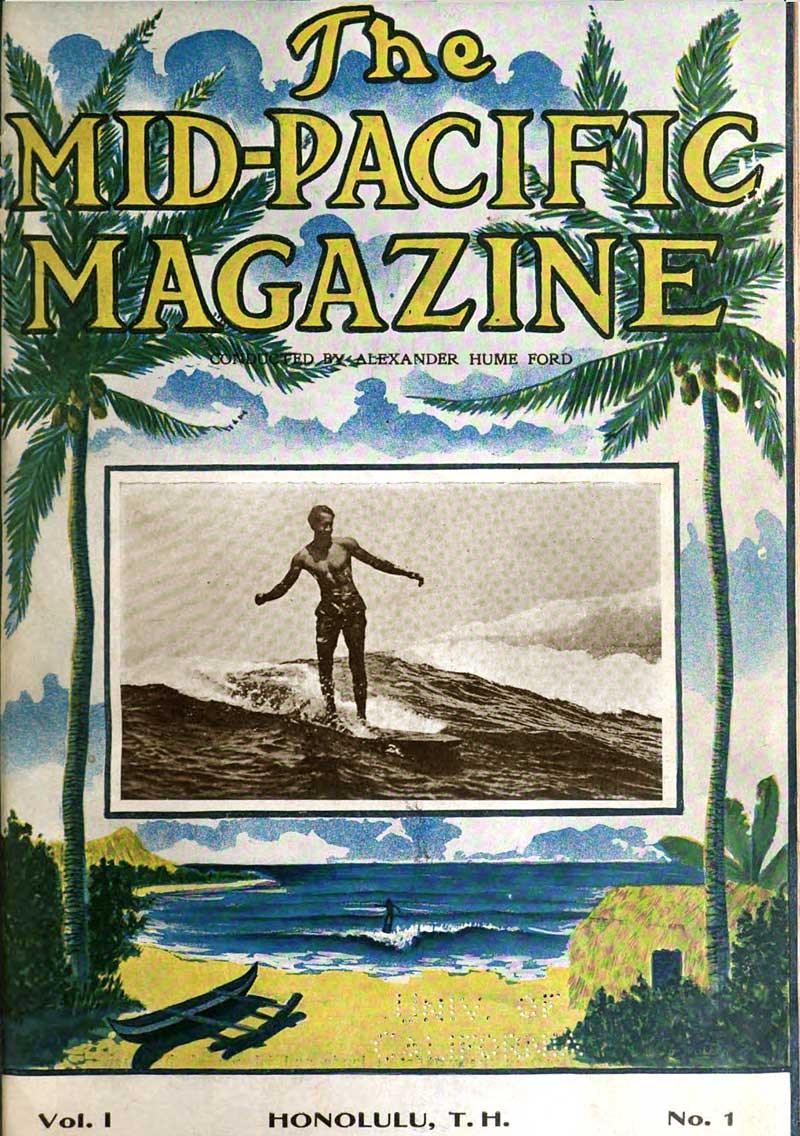 For the first issue of The Mid-Pacific Magazine in Jan., 1911, A.R.Gurrey Jr.'s photo from 1910 of Duke Kahanamoku riding a surfboard in Waikiki was published as part of the front color cover designed by artist Stuart S. Tabor. Acknowledged today as the father of surfing photography, Gurrey Jr.'s working methods in a 1912 article stated: "It necessitated going right out against the incoming surf, right at its height and meant invariably a swamping of the canoe and soaking for all in it. Mr. Gurrey felt amply repaid for his day's outing if at the end of the day he returned with his camera and one unspoiled negative out of twelve." from: Hathi Trust
For the first issue of The Mid-Pacific Magazine in Jan., 1911, A.R.Gurrey Jr.'s photo from 1910 of Duke Kahanamoku riding a surfboard in Waikiki was published as part of the front color cover designed by artist Stuart S. Tabor. Acknowledged today as the father of surfing photography, Gurrey Jr.'s working methods in a 1912 article stated: "It necessitated going right out against the incoming surf, right at its height and meant invariably a swamping of the canoe and soaking for all in it. Mr. Gurrey felt amply repaid for his day's outing if at the end of the day he returned with his camera and one unspoiled negative out of twelve." from: Hathi Trust
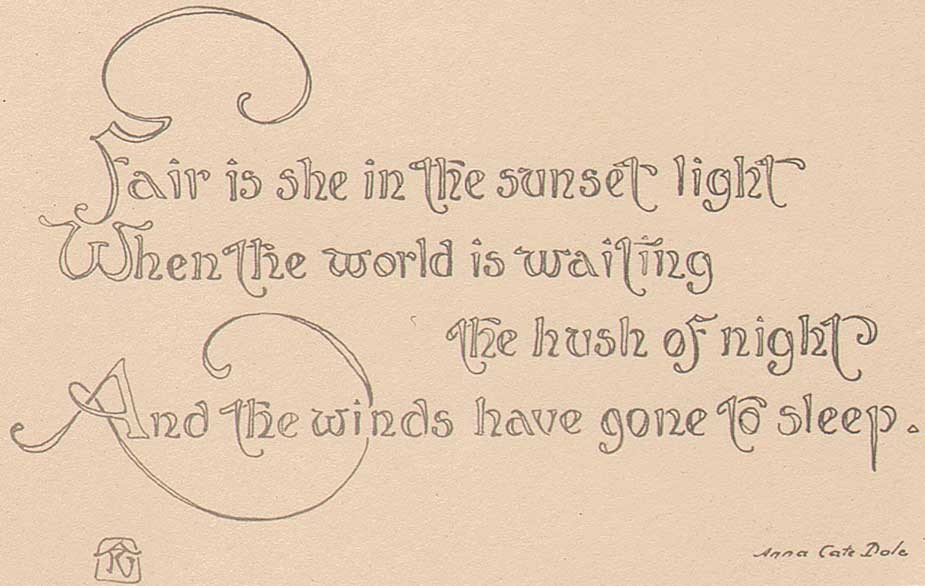 Detail: A.R. Gurrey Jr., American: photo-transfer of calligraphic text from poem "A Psalm for Hawaii" by Anna Cate Dole published in "Idyls of Hawaii" ca. 1910-20. Calligraphy was an important art-form practiced by Gurrey; so much so he often signed this work in "Idyls" using his stylized monogram seen above at lower left corner. from: PhotoSeed Archive
Detail: A.R. Gurrey Jr., American: photo-transfer of calligraphic text from poem "A Psalm for Hawaii" by Anna Cate Dole published in "Idyls of Hawaii" ca. 1910-20. Calligraphy was an important art-form practiced by Gurrey; so much so he often signed this work in "Idyls" using his stylized monogram seen above at lower left corner. from: PhotoSeed Archive
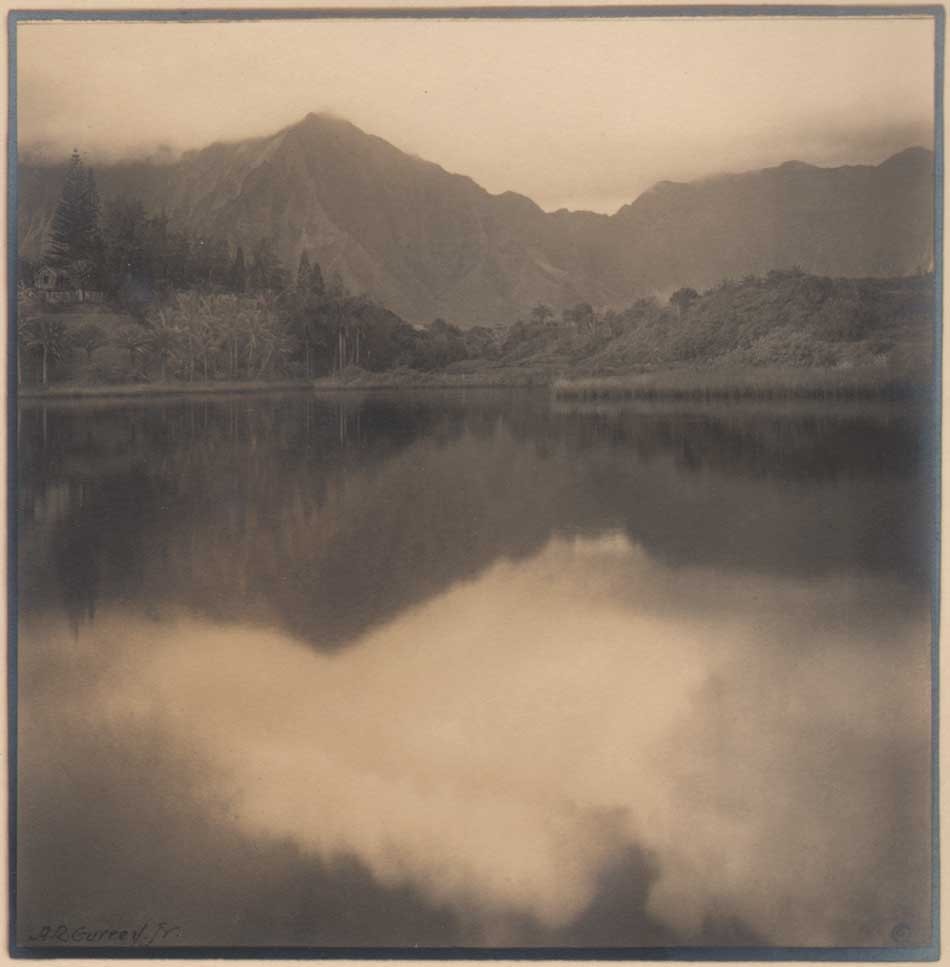 A.R. Gurrey Jr., American: "Fair is she in the morning light…" ca. 1910-20: vintage gelatin silver print used as frontis leaf included in volume "Idyls of Hawaii" (11.5 x 11.2 | 25.0 x 19.8 cm) Illustrating lines from the Anna Cate Dole poem "A Psalm for Hawaii" written ca. 1909, Gurrey's photograph of a mountainous Hawaiian landscape with her peaks and lake reflection shrouded in clouds confirms this place as idyllic. From: PhotoSeed Archive
A.R. Gurrey Jr., American: "Fair is she in the morning light…" ca. 1910-20: vintage gelatin silver print used as frontis leaf included in volume "Idyls of Hawaii" (11.5 x 11.2 | 25.0 x 19.8 cm) Illustrating lines from the Anna Cate Dole poem "A Psalm for Hawaii" written ca. 1909, Gurrey's photograph of a mountainous Hawaiian landscape with her peaks and lake reflection shrouded in clouds confirms this place as idyllic. From: PhotoSeed Archive
Photographer Alfred Richard Gurrey Jr. believed in that place. A Hawaiian transplant from San Francisco at the turn of the 20th Century, his beautiful photographs of the islands included in the self-published book Idyls of Hawaii ca. 1910-1920 now on this website is aptly titled, even if idyll is now spelled with two ls in the 21st. A truly renaissance man of the arts, his vision of beauty for a place we may never visit but hope to someday cannot help but give us all the hope we need in this hectic and often indifferent world- one where the idea of Hawaii can always be within reach. -David Spencer
Want to see more of this special place from long ago? click here
Step right up and see the show!
Posted March 2015 in New Additions, Significant Photographs
P.T. Barnum gave me permission. A recent news item that Ringling Bros. and Barnum & Bailey Circus would send their remaining ponderous performing pachyderms to a Florida retirement home by 2018 got me to thinking recently. Did I not possess in my archive one very old mysterious photograph of a stuffed elephant? Sure enough, I did.
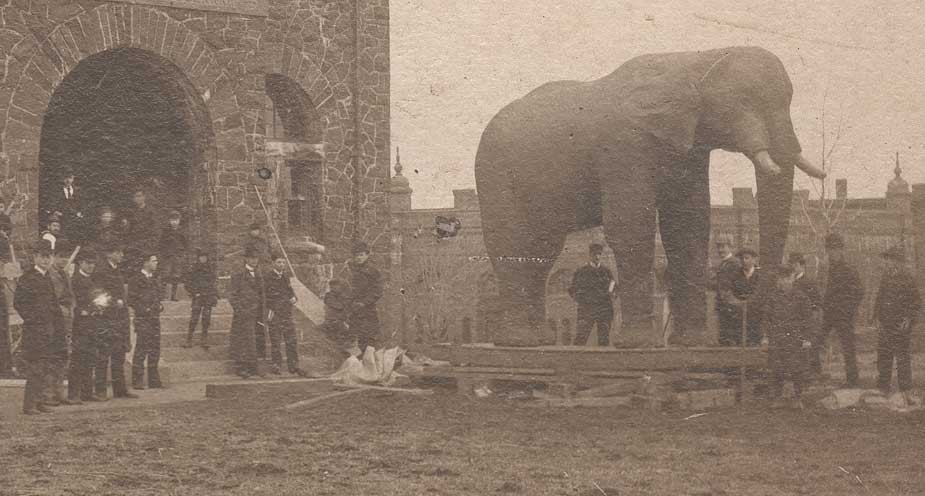 Detail: "Moving Jumbo into Barnum Museum, 1889" (assigned title by Tufts University Archives- see variant:ID: tufts:UA136.002.DO.00823 ): Attributed photographer: Charles Rollins Tucker, American (b. 1868): 1889: mounted brown-toned gelatin silver print on cabinet card: 8.3 x 11.0 cm | 10.8 x 13.2 cm. This rare photograph believed to have been taken on April 3, 1889 posthumously shows the famed circus elephant Jumbo (died 1885) formerly owned by circus showman P.T. Barnum sitting outside the Barnum Museum of Natural History on the Tufts College campus in Medford, Mass. before being placed on display. Vintage photograph from: PhotoSeed Archive.
Detail: "Moving Jumbo into Barnum Museum, 1889" (assigned title by Tufts University Archives- see variant:ID: tufts:UA136.002.DO.00823 ): Attributed photographer: Charles Rollins Tucker, American (b. 1868): 1889: mounted brown-toned gelatin silver print on cabinet card: 8.3 x 11.0 cm | 10.8 x 13.2 cm. This rare photograph believed to have been taken on April 3, 1889 posthumously shows the famed circus elephant Jumbo (died 1885) formerly owned by circus showman P.T. Barnum sitting outside the Barnum Museum of Natural History on the Tufts College campus in Medford, Mass. before being placed on display. Vintage photograph from: PhotoSeed Archive.
Looks kinda important.
Bunch of people standing outside a building… with a really big stuffed elephant.
Now to some Google “research”.
It’s Jumbo!
As in: “Jumbo was the greatest circus attraction in American history.” (1.)
So now I’m more interested in that old photo. But then it dawns on me: several years ago, I had purchased a trove of material taken by an amateur photographer named Charles Rollins Tucker. Never heard of him? Tufts College. Class of 1891. Bachelor of Philosophy with specialties in chemistry and physics, then a Master of Arts from the same institution in 1894. From Stoughton, Massachusetts, Tucker first resided in East Hall (room 26) on the Tufts campus after first matriculating in the Fall of 1887. Trust me. I know a great deal more, and eventually, time willing, you will too. Several photographs of his daughter Dorothy, (also a Tufts graduate) including “Girl with Kodak“ and an earlier study of her photographing her doll have been hiding in plain site on this website for several years now, and I eventually hope to show the progression of her growing up in a wonderful series of images taken by her father.
But now back to the main attraction, that old photograph. Like I said, Barnum would approve.
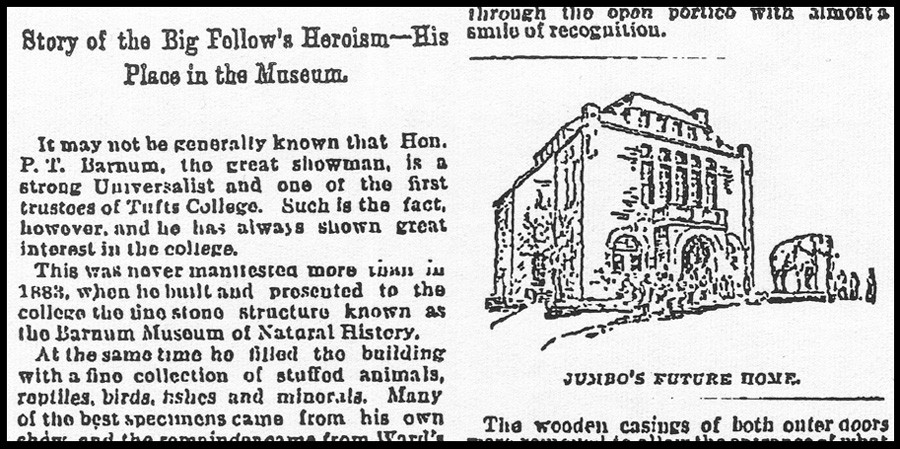 A woodcut taken from the Charles Tucker photograph of Jumbo before being placed on display inside the Barnum Museum of Natural History on the Tufts College campus on April 3, 1889 is one of two accompanying an article written by Tufts graduate and Boston Daily Globe reporter Julien C. Edgerly for the April 4, 1889 edition of the newspaper.
A woodcut taken from the Charles Tucker photograph of Jumbo before being placed on display inside the Barnum Museum of Natural History on the Tufts College campus on April 3, 1889 is one of two accompanying an article written by Tufts graduate and Boston Daily Globe reporter Julien C. Edgerly for the April 4, 1889 edition of the newspaper.
The Particulars
Jumbo, a word synonymous with someone or something very large or huge-especially so in the American lexicon, was an African elephant of immense proportions. According to Wikipedia, he was also the first “international animal superstar” after showman Phineas Taylor Barnum (1810-1891) purchased him from the London Zoo in 1882 for $10,000. However, in September of 1885, after entertaining North American circus audiences for a bit more than 3 years, he came to an inglorious end after being accidentally struck by a freight train after a Canadian performance.
Barnum being Barnum, a little thing like death was certainly not going to get in the way of Jumbo thrilling audiences while continuing to replenish his masters coffers- albeit in a more restrained and static way. An early trustee and munificent benefactor of the school, he gave it $55,000 in 1882 for the establishment of the Barnum Museum of Natural History on the campus, which was completed by 1884. Housing a museum of natural history showcasing a multitude of stuffed circus and zoological animal specimens as well as laboratories and classrooms, arrangements for Jumbo’s remains had been planned even while he was still alive. Overseeing the museum was John Marshall, the first professor of natural history at the school, who had presciently written to Henry A. Ward, Barnum’s taxidermist extraordinaire and owner of the “Natural Science Establishment” in Rochester, N.Y. two weeks before Jumbo’s death:
College Hill. Sep 1. 1885.
Dear Prof. Ward.
We fully expect to have the skin of Jumbo when he dies. Jumbo was excepted when the arrangement was made with the Smithsonian. I should not consider the Barnum Museum complete without this noble animal. It would be the greatest ornament that we could place in the Vestibule, near Mr. Barnum’s bust. Our front door to the Museum is [blank] feet high. You can judge whether the stuffed Jumbo would go in. It is wide enough, I think. Probably it would be necessary to stuff the skin in the vestibule. I have not decided upon the skeleton yet but will endeavor to let you know soon. - I think your offer to Mr. Barnum was $75 in exchange or $50 in money. Would you object to letting the $50 go towards the skulls? -
Yours very truly.
John P. Marshall (2.)
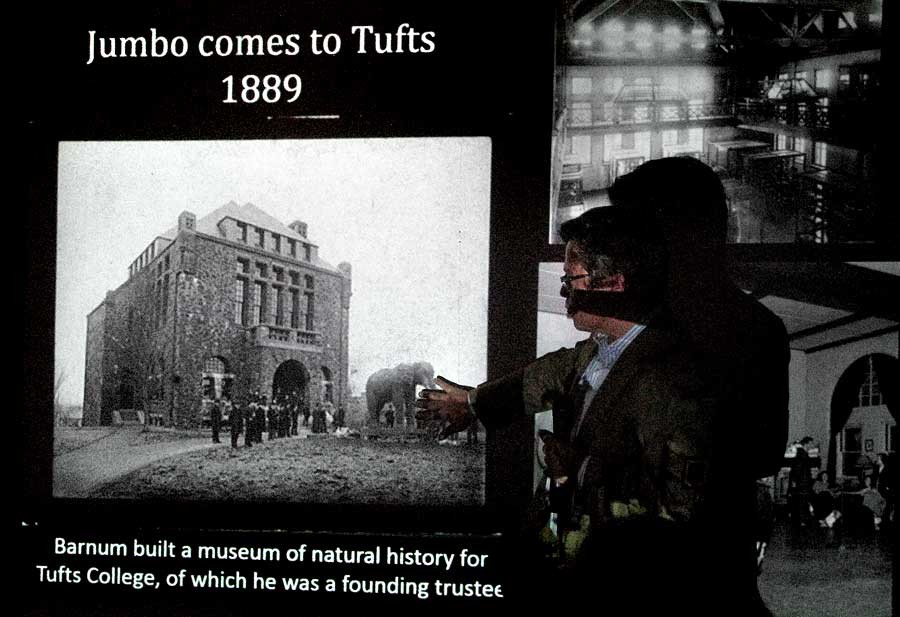 Tufts University Professor of Art History Dr. Andrew McClellan points to the photograph of the stuffed Jumbo before the elephant was placed on display inside the natural history museum on the Tufts campus in 1889 during a public lecture he gave at the Barnum Museum in Bridgeport, CT in April, 2015. In 2014, for the 125th anniversary of the arrival of Jumbo at Tufts, McClellan curated the life story of the famed elephant as part of the exhibit "Jumbo: Marvel, Myth, and Mascot", with the university publishing a pictorial monograph authored by him by the same title. Photo by David Spencer/PhotoSeed Archive
Tufts University Professor of Art History Dr. Andrew McClellan points to the photograph of the stuffed Jumbo before the elephant was placed on display inside the natural history museum on the Tufts campus in 1889 during a public lecture he gave at the Barnum Museum in Bridgeport, CT in April, 2015. In 2014, for the 125th anniversary of the arrival of Jumbo at Tufts, McClellan curated the life story of the famed elephant as part of the exhibit "Jumbo: Marvel, Myth, and Mascot", with the university publishing a pictorial monograph authored by him by the same title. Photo by David Spencer/PhotoSeed Archive
After Jumbo’s demise, Ward was dispatched to Canada in order to secure the animal’s remains, not an easy task. Arriving two days after the accident on Sept. 17, souvenir seekers had to be kept at bay by police:
In addition to the problem of size, Jumbo’s fame caused added complications. Relic seekers had done some damage before Ward arrived, and a policeman had been put on guard to prevent further mutilation. It took Ward, his assistants, and half a dozen butchers from St. Thomas, two days to dissect the elephant and prepare the hide and skeleton for shipment. The hide weighed 1,538 pounds, the bones 2,400 pounds. Coins of many kinds were found in Jumbo’s stomach, and Ward was quoted as having said that “Jumbo was a bank all by himself.” His stomach also contained rivets, a bunch of keys on a ring, a policeman’s whistle, and various ornaments. (3.)
By March of the following year, after his skin had been tanned and “scraped to a uniform thickness and nailed to a huge wooden framework with 74,480 nails”, (4.) Ward’s Natural Science Establishment delivered two finished mounts of Jumbo to Barnum at a reported cost of $1200.00: (5.) one of his skeleton and another for his hide. This stuffed version of Jumbo, after two additional years of touring with The Greatest Show on Earth, eventually made its’ way to Medford and the college via train after Barnum made the decision to (mostly) “retire” him from traveling circus life.
A Rare Survivor
With this mounted cabinet card seemingly the only photographic evidence of his arrival on campus, it must have been quite a sight to see all the steps taken to safely transport Jumbo by train, ferryboat and horse-drawn carriage on his final journey to Tufts. Beginning on Friday, March 29 from his winter home in Bridgeport, CT , Jumbo finally arrived in front of the Barnum museum at the college on Wednesday, April 3, 1889, with the final leg of the journey described as:
…” he was hauled to Tufts by a double team of horses. When that team proved unable to pull him up College Hill, more than 50 Tufts professors and students, aided by some local boys, completed the task.” (6.)
An alternate dispatch from 1888 Tufts graduate Julien C. Edgerly, (1865-1913) a reporter and news editor for the Boston Daily Globe newspaper who witnessed the famed elephants arrival on campus, wrote an article published in the edition for Thursday, April 4, 1889, illustrated by a small woodcut of the mounted cabinet card seen here. Conclusive proof it was taken by Tufts student Charles Rollins Tucker-albeit without being named directly-was included in Edgerly’s article. Some excerpts:
The mounted skin of Jumbo this morning stands in front of the museum on the top of College hill, as shown in the accompanying cuts, one of which shows the animal with a man at his side to give by contrast an idea of his size, and the other shows both Jumbo and the building which, barring the cadence of fortune, is destined to be his last long home. …
After Jumbo made his final journey, pulled by 6 horses up College Hill to the front doors of the Barnum Museum, the carriage he was riding on was “taken apart and drawn away.” … and:
The canvas coverings were removed to allow a student photographer to transfer his image to the plate of the camera. Several views were taken, some with ambitious young men upon the great beast’s back. Then the coverings were replaced and he will stand as lone sentinel till today when he will be placed inside the museum. He will occupy the centre of the large front room, facing the entrance. (7.)
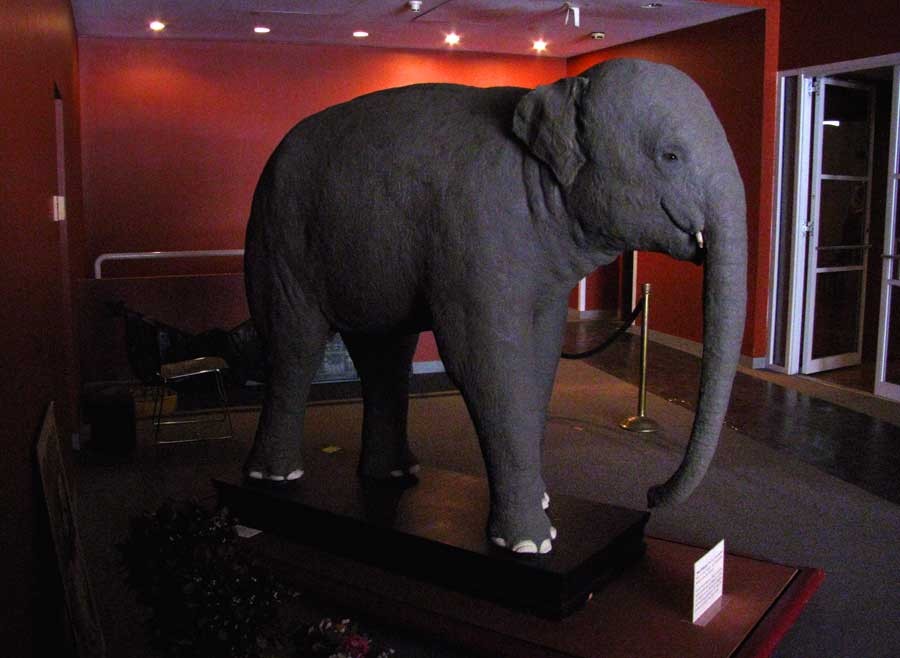 A survivor indeed. Standing nearly 7' and weighing 700 pounds, "Baby Bridgeport" is a preserved Asian elephant that was only the second elephant born in captivity in America owned by P.T. Barnum. Similarly mounted like Jumbo by taxidermist Henry Ward when he died at four years of age in 1886 and originally displayed alongside Jumbo inside the Barnum museum at Tufts in 1889, Baby Bridgeport continues to be a popular attraction for visitors to the Barnum Museum in Bridgeport, CT seen here in April, 2015. Photo by David Spencer/PhotoSeed Archive
A survivor indeed. Standing nearly 7' and weighing 700 pounds, "Baby Bridgeport" is a preserved Asian elephant that was only the second elephant born in captivity in America owned by P.T. Barnum. Similarly mounted like Jumbo by taxidermist Henry Ward when he died at four years of age in 1886 and originally displayed alongside Jumbo inside the Barnum museum at Tufts in 1889, Baby Bridgeport continues to be a popular attraction for visitors to the Barnum Museum in Bridgeport, CT seen here in April, 2015. Photo by David Spencer/PhotoSeed Archive
Professor Marshall, writing in the Annual Report of the President of Tufts College for 1889, also gave an interesting account of Jumbo’s arrival that day, commenting Jumbo had increased visitors to the museum among other observations:
Jumbo was brought to the Barnum Museum on Fast Day of the present year, and moved into the vestibule the following day. All the wood-work was removed from the great arch of the portico, leaving barely room for the entrance of the largest mounted elephant of modern times. It will be taken away, September 20, to be exhibited in London during the coming winter. About the first of April of next year, it will become a permanent attraction of the Museum. During the five months of its exhibition here the number of visitors to the Museum was largely increased. Your attention is again respectfully invited to the need of additional cases for the proper exhibition of specimens which have been accumulating during the past two years.
Respectfully submitted,
JOHN P. MARSHALL,
Director. Tufts College,
September 19, 1889. (8.)
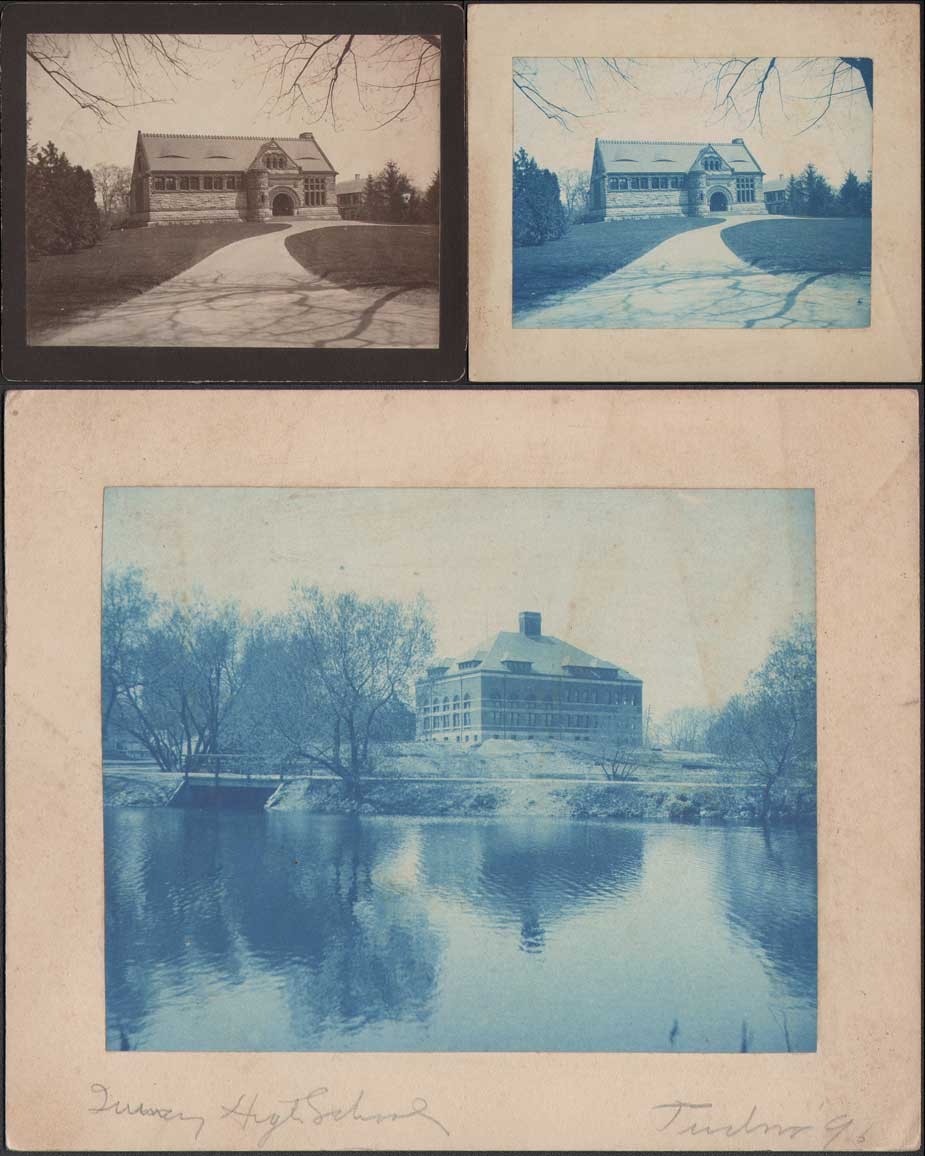 Top left: Exterior entrance view showing the Thomas Crane Public Library (built 1882) by architect Henry Hobson Richardson in Quincy, Mass. : Attributed photographer: Charles Rollins Tucker, American (b. 1868):Vintage brown-toned gelatin silver print on cabinet card: 9.0 x 11.8 cm | 10.8 x 13.2 cm. Top Right: Exterior entrance view showing the Thomas Crane Public Library (built 1882) by architect Henry Hobson Richardson in Quincy, Mass. : Attributed photographer: Charles Rollins Tucker, American (b. 1868): 1896: Vintage cyanotype print on cabinet card: 9.1 x 12.0 cm | 12.7 x 15.2 cm. Bottom: Exterior view of "Quincy High School" with pond in foreground: Signed lower right: "Tucker '96": Charles Rollins Tucker, American (b. 1868):Vintage cyanotype print on cabinet card: 9.4 x 11.9 cm | 12.7 x 15.3 cm. All from: PhotoSeed Archive
Top left: Exterior entrance view showing the Thomas Crane Public Library (built 1882) by architect Henry Hobson Richardson in Quincy, Mass. : Attributed photographer: Charles Rollins Tucker, American (b. 1868):Vintage brown-toned gelatin silver print on cabinet card: 9.0 x 11.8 cm | 10.8 x 13.2 cm. Top Right: Exterior entrance view showing the Thomas Crane Public Library (built 1882) by architect Henry Hobson Richardson in Quincy, Mass. : Attributed photographer: Charles Rollins Tucker, American (b. 1868): 1896: Vintage cyanotype print on cabinet card: 9.1 x 12.0 cm | 12.7 x 15.2 cm. Bottom: Exterior view of "Quincy High School" with pond in foreground: Signed lower right: "Tucker '96": Charles Rollins Tucker, American (b. 1868):Vintage cyanotype print on cabinet card: 9.4 x 11.9 cm | 12.7 x 15.3 cm. All from: PhotoSeed Archive
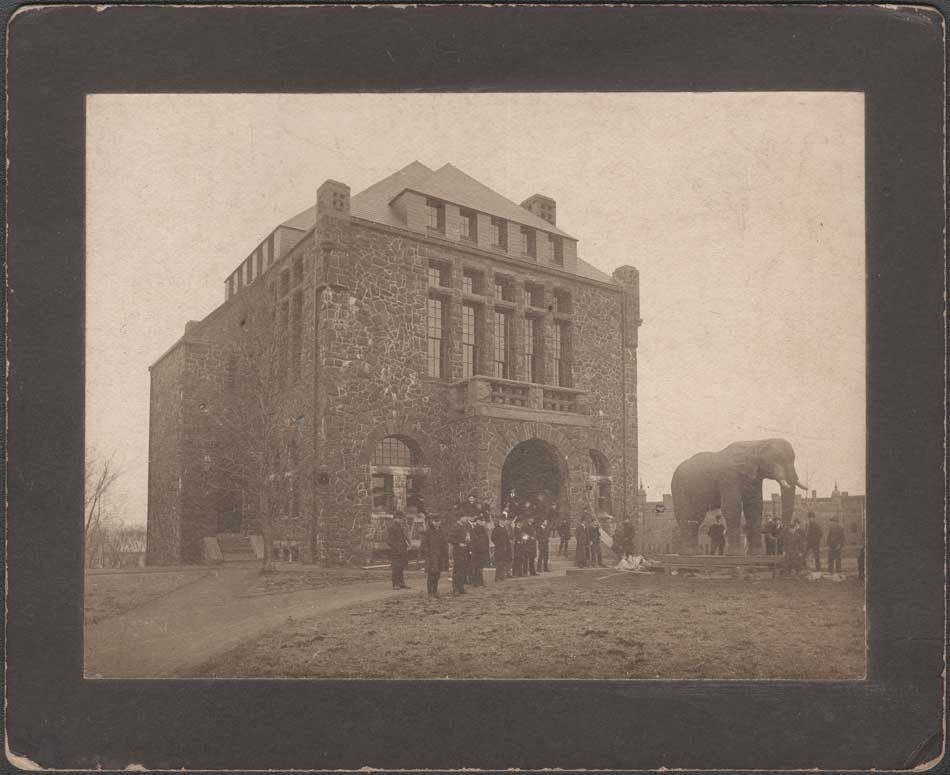 "Moving Jumbo into Barnum Museum, 1889" (assigned title by Tufts University Archives- see variant:ID: tufts:UA136.002.DO.00823 ): Attributed photographer: Charles Rollins Tucker, American (b. 1868): 1889: mounted brown-toned gelatin silver print on cabinet card: 8.3 x 11.0 cm | 10.8 x 13.2 cm. This rare photograph taken on April, 3 1889 posthumously shows the famed circus elephant Jumbo (died 1885) once owned by circus showman P.T. Barnum, now stuffed, sitting outside the Barnum Museum of Natural History on the Tufts College campus in Medford, Mass. before being placed on display. Vintage photograph from: PhotoSeed Archive.
"Moving Jumbo into Barnum Museum, 1889" (assigned title by Tufts University Archives- see variant:ID: tufts:UA136.002.DO.00823 ): Attributed photographer: Charles Rollins Tucker, American (b. 1868): 1889: mounted brown-toned gelatin silver print on cabinet card: 8.3 x 11.0 cm | 10.8 x 13.2 cm. This rare photograph taken on April, 3 1889 posthumously shows the famed circus elephant Jumbo (died 1885) once owned by circus showman P.T. Barnum, now stuffed, sitting outside the Barnum Museum of Natural History on the Tufts College campus in Medford, Mass. before being placed on display. Vintage photograph from: PhotoSeed Archive.
Picking up the Ashes
Jumbo has given back to Tufts, no pun intended, in a Huge way. Period accounts state he was immediately adopted as the school’s new mascot shortly after his arrival in 1889 and continues in that role today at Tufts University. The school website, semantics aside, brags Jumbo is the “only college mascot found in Webster’s Dictionary.” But alas, Jumbo endured a second death, this time by fire in 1975, when faulty wiring lead to a conflagration that gutted the 1884 Barnum museum. But all was not lost. Fortunately, the school’s archives held a section of Jumbo’s tail removed earlier because of students continual penchant for tugging on it, and a university staff member, while the rubble was still smoldering, had the smarts to scoop up some of his ashes that now reside in a Skippy peanut butter jar at the school. (nice trivia question- it’s secured with a Peter Pan Crunchy brand lid) Members of the sports teams on campus are said to rub this jar for good luck before an important game, and students indelible memories of college life at Tufts have been published every year since 1917 in the “Jumbo” yearbook.
With reporter Julien Edgerly’s account of a Tufts student photographer recording Jumbo for posterity in front of the museum on April 3, 1889, my argument and “Conclusive proof” Charles Rollins Tucker was that author working with Edgerly seems credible. For comparison, the Tufts archives holds a photograph dated 1889 showing Jumbo later on exhibit inside the museum credited to noted marine photographer N. L. Stebbins. (Nathaniel Livermore Stebbins-1847-1922) But given Jumbo’s immense fame, why is there no back-mark or other attribution for Stebbins for this exterior view of Jumbo? Surely, like one of his famous yachting studies, Stebbins would have insisted on it!
On his way to becoming a fine pictorialist photographer in the early 20th Century, Charles Tucker took a series of architectural photographs that survive in this archive which further gives credibility to his being responsible for the 1889 exterior Jumbo photograph. These include several examples seen above showing (ca. 1890-95) one of architect Henry Hobson Richardson’s masterpieces, the Thomas Crane Public Library (built 1882) located in Quincy, south of Boston. This is a gelatin silver mounted cabinet card using the same card-stock as the Jumbo photograph as well as a variant mounted cyanotype on a different paper stock. Finally, when he finished with his masters degree in late 1894 at Tufts, Tucker became sub-master until 1896 at Quincy High School- the same town as Richardson’s library. Two of his photographic views of this additionally survive, with a card-mounted, signed cyanotype by him dated 1896 seen here.
Notes:
1. excerpt: Step Right Up! : Bob Brooke presents the history of the circus in America : from: History Magazine: October/November 2001 issue: online version accessed March, 2015.
2. excerpt: Jumbo: by John R. Russell: in: University of Rochester Library Bulletin: vol. III, no. 1: Fall, 1947: River Campus Libraries online resource accessed March, 2015
3. Ibid
4. excerpt: Jumbo: Here and There at Tufts: Medford: Tufts College: Lewis Doane, Editor-in-chief: 1907: p. 44
5. excerpt: Jumbo: by John R. Russell: in: University of Rochester Library Bulletin: vol. III, no. 1: Fall, 1947: River Campus Libraries online resource accessed March, 2015
6. excerpt: Jumbo Matriculates: from: An Elephant’s Tale: Susan Wilson, J69, G75: Tufts online Magazine: Spring, 2002
7. The Boston Daily Globe: Thursday, April 4, 1889: p. 4
8. excerpt: Annual Report of the President of Tufts College: Boston: 1889: p. 36
Silent Night
Posted December 2014 in Exhibitions, New Additions, Significant Photographs
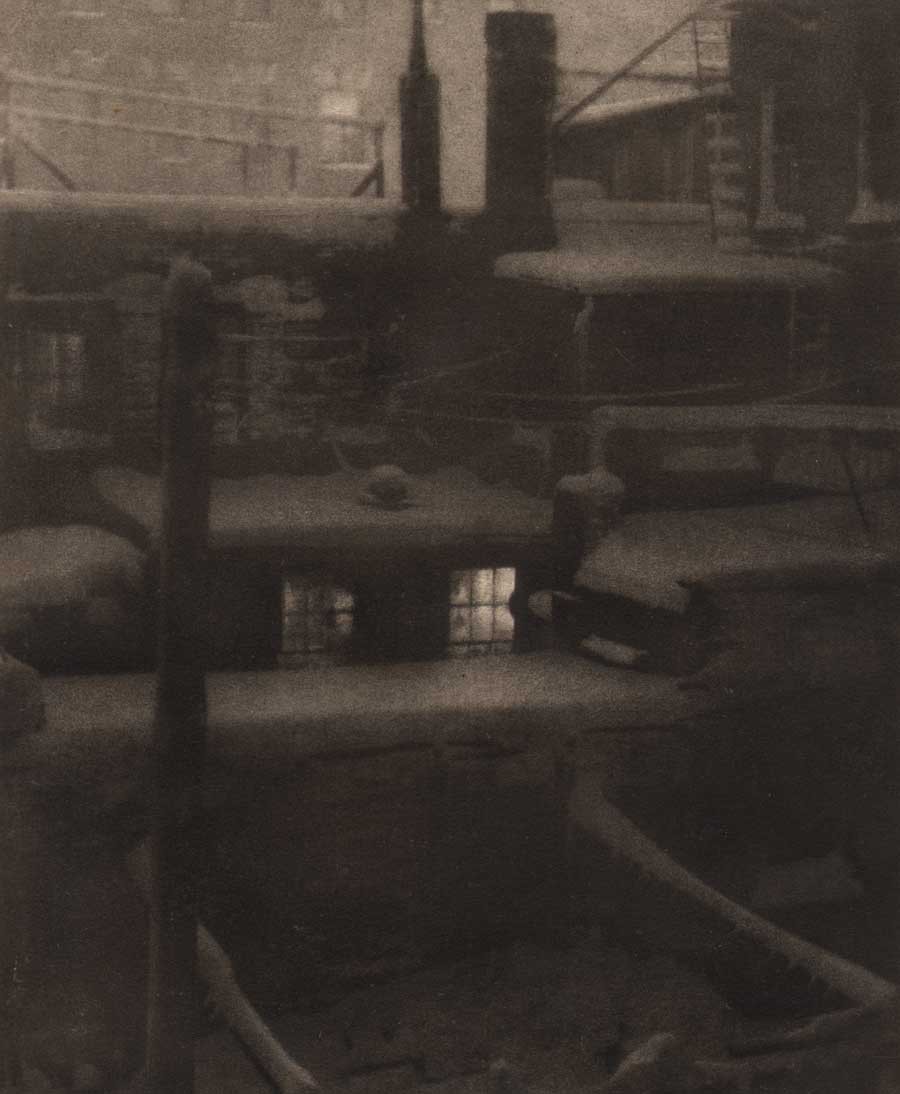 Detail: "Thru the Back Window": Charles A. Hellmuth: American: vintage 1924 Wellington bromoil print: 32.1 x 24.0 cm | 50.7 x 40.6 cm: from: PhotoSeed Archive
Detail: "Thru the Back Window": Charles A. Hellmuth: American: vintage 1924 Wellington bromoil print: 32.1 x 24.0 cm | 50.7 x 40.6 cm: from: PhotoSeed Archive
Genre meets Genius
Posted November 2014 in Engraving, New Additions, Painters|Photographers, Significant Photographers, Typography
Although long forgotten, amateur photographer John E. Dumont (1856-1944) figures prominently in the early years of American pictorial photography. However, a professional and better known acquaintance of his may change our understanding after my discovery of a small label on the back of a Dumont print made its’ way into the archive.
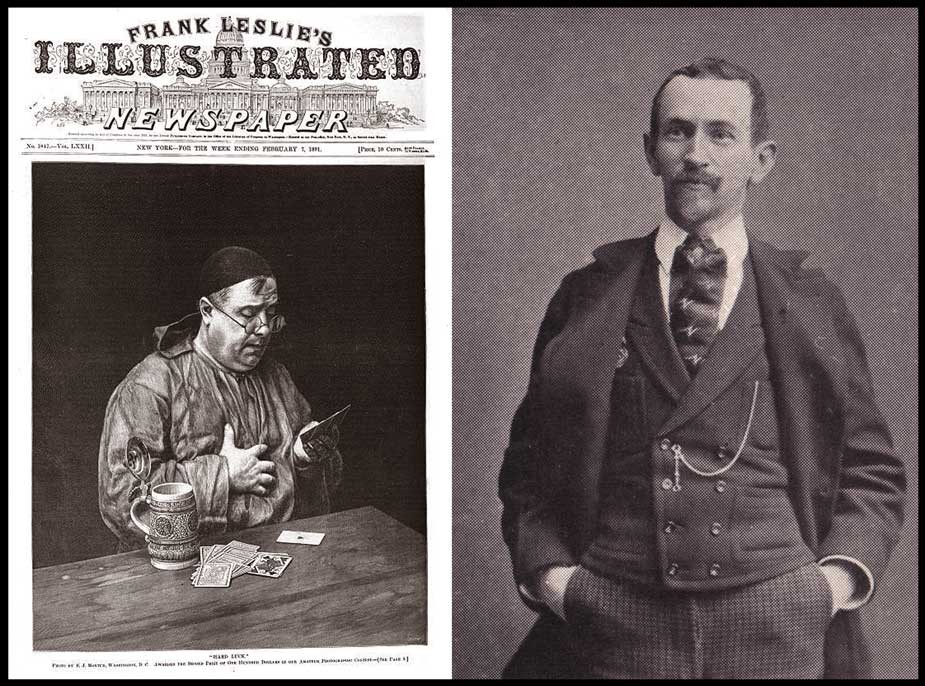 Left: "Hard Luck", showing a monk playing a losing hand of cards, was most likely taken by John E. Dumont in 1890. Shown here as the cover illustration of Frank Leslie's Illustrated Newspaper for Feb. 7, 1891, it is reproduced as a wood engraving from the original photograph, and earned Dumont a second place award and $100.00 in Leslie's Amateur Photographic Contest which closed in January, 1891. Dumont went on to copyright "Hard Luck" in 1892. (original from Pennsylvania State University) Right: Halftone portrait of photographer John E. Dumont of Rochester, New York by unknown photographer. 6.3 x 4.7 cm. Reproduced as part of a series of portraits of "Prominent Amateur Photographers" in the Nov., 1893 issue of the American Amateur Photographer journal. (p. 513) : from: PhotoSeed Archive
Left: "Hard Luck", showing a monk playing a losing hand of cards, was most likely taken by John E. Dumont in 1890. Shown here as the cover illustration of Frank Leslie's Illustrated Newspaper for Feb. 7, 1891, it is reproduced as a wood engraving from the original photograph, and earned Dumont a second place award and $100.00 in Leslie's Amateur Photographic Contest which closed in January, 1891. Dumont went on to copyright "Hard Luck" in 1892. (original from Pennsylvania State University) Right: Halftone portrait of photographer John E. Dumont of Rochester, New York by unknown photographer. 6.3 x 4.7 cm. Reproduced as part of a series of portraits of "Prominent Amateur Photographers" in the Nov., 1893 issue of the American Amateur Photographer journal. (p. 513) : from: PhotoSeed Archive
Established in business beginning in 1881 in Rochester, New York as a wholesale merchandise and grocery broker specializing in items like sugars, teas, and coffees, Dumont took up photography in 1884 and was soon entering and winning awards in photographic salons around the world.
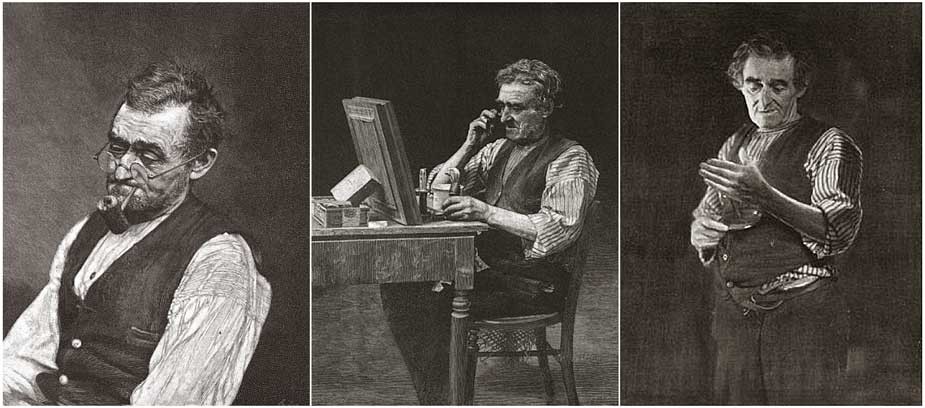 Taken in 1887, photographer John E. Dumont of Rochester, New York made this series of genre portrait photographs of a gentleman he described as "an old man who used to peddle oranges around the streets and offices in this city". Left: "A Quite Pipe": woodcut engraved from a copyright photograph from Leslie's Illustrated Newspaper Amateur Photographic Contest: published Jan., 17, 1891. Middle: "The Old Shaver": woodcut engraved from a copyright photograph from Leslie's Illustrated Newspaper Amateur Photographic Contest: published Jan., 24, 1891. Right: "The Toiler's Good-Night" : woodcut engraved from a copyright photograph illustrating a poem from Leslie's Illustrated Weekly: published Dec., 14, 1893: originals from Pennsylvania State University
Taken in 1887, photographer John E. Dumont of Rochester, New York made this series of genre portrait photographs of a gentleman he described as "an old man who used to peddle oranges around the streets and offices in this city". Left: "A Quite Pipe": woodcut engraved from a copyright photograph from Leslie's Illustrated Newspaper Amateur Photographic Contest: published Jan., 17, 1891. Middle: "The Old Shaver": woodcut engraved from a copyright photograph from Leslie's Illustrated Newspaper Amateur Photographic Contest: published Jan., 24, 1891. Right: "The Toiler's Good-Night" : woodcut engraved from a copyright photograph illustrating a poem from Leslie's Illustrated Weekly: published Dec., 14, 1893: originals from Pennsylvania State University
Specializing in genre scenes, his photographs were published frequently, reaching a high point when his well known study of a monk playing a losing hand of cards titled Hard Luck was published as the cover illustration (converted to a wood engraving) for Frank Leslie’s Illustrated Newspaper in early 1891, the same year he won a grand diploma at the groundbreaking Vienna Salon of Photographic Art, the highest accolade awarded for the very few American entrants whose work was even accepted, including the now venerable Alfred Stieglitz, who had only come back to America from Europe the year before.
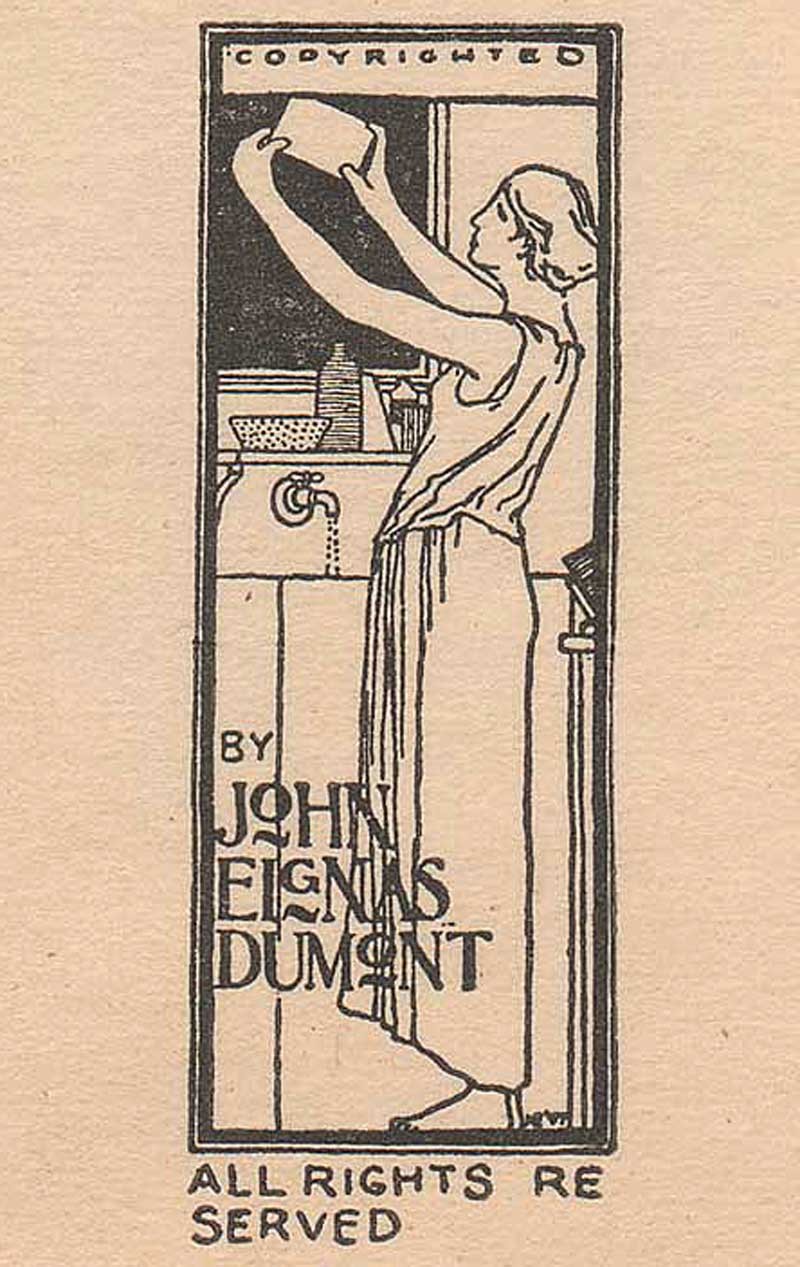 Artist: Harvey Ellis, American: 1897: medium: wood engraving: subject: copyright label for amateur American photographer John Eignas Dumont. Plate intended to represent "the genius of photography surrounded by the accessories of the "dark room." Design: 3.4 x 1.3 cm | Label: 7.0 x 4.5 cm. Label is a variant of an ex libris bookplate Ellis designed for Dumont. from: PhotoSeed Archive
Artist: Harvey Ellis, American: 1897: medium: wood engraving: subject: copyright label for amateur American photographer John Eignas Dumont. Plate intended to represent "the genius of photography surrounded by the accessories of the "dark room." Design: 3.4 x 1.3 cm | Label: 7.0 x 4.5 cm. Label is a variant of an ex libris bookplate Ellis designed for Dumont. from: PhotoSeed Archive
It was therefore a delightful discovery which took place for me recently after a signed Dumont carbon print of The Dice Players exhibited in the Royal Photographic Societies’ annual salon the same year as the Vienna exhibition was acquired for the archive. But what makes it special for the confluence of art photography and evidence a new incarnation of the English Arts & Crafts movement had taken hold after arriving on American shores was a later 1897 copyright label affixed to the rear of the mounted print. A design featuring an Art-Nouveau style woodcut engraving of a woman in a darkroom holding up a glass plate, I soon discovered it was the work of noted American artist, architect and designer Harvey Ellis. (1852-1904)
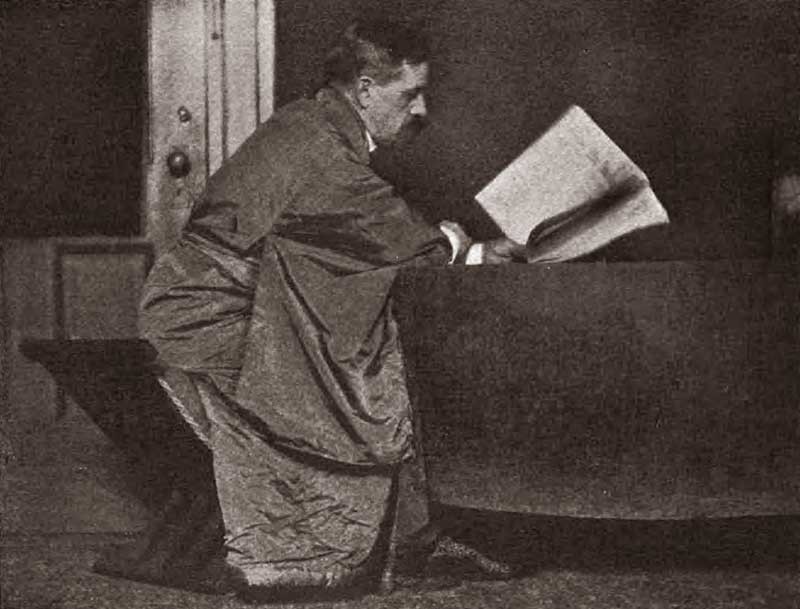 Photographic portrait of American artist, architect and designer Harvey Ellis. (1852-1904) unknown photographer: reproduced as halftone and published in the Dec., 1908 issue of The Architectural Review illustrating article on Ellis by Claude Bragdon titled Harvey Ellis: A Portrait Sketch: p. 173. Original from The University of Michigan
Photographic portrait of American artist, architect and designer Harvey Ellis. (1852-1904) unknown photographer: reproduced as halftone and published in the Dec., 1908 issue of The Architectural Review illustrating article on Ellis by Claude Bragdon titled Harvey Ellis: A Portrait Sketch: p. 173. Original from The University of Michigan
Never heard of him? Today, Ellis seems only to be remembered for the brief work he did in the last months of his life in 1903 for among other things, designing mission-style furniture and interior renderings of Craftsman homes in the Syracuse, New York-based architecture department for his American employer, Gustav Stickley, (1858-1942) the leader of the nascent American Arts and Crafts movement. But this is far from a full portrait of Ellis. A contemporary- architect, author, and theater designer Claude Bragdon- (1866-1946) gave a fuller account of Harvey Ellis in a posthumous outline for the December, 1908 issue of The Architectural Review. A few excerpts:
HARVEY ELLIS was a genius. This is a statement which may excite only incredulity in the minds of the many who never heard his name or knew him only by his published drawings, but it will have the instant concurrence of the few who knew well the man himself. There is the genius which achieves, and the genius which inspires others to achievement. Had it not been for the evil fairy (alcohol-editor) which presided at his birth and ruled his destiny, Harvey Ellis might have been numbered among the former; that is, he might have been a prominent, instead of an obscure, figure in that aesthetic awakening of America, now going on, of which he was among the pioneers; but even so he exercised an influence more potent than some whose names are better remembered. (p. 173)
 Although many designs by Harvey Ellis were never realized in the physical form, there are notable exceptions. The Compton Hill Water Tower in Reservoir Park, St. Louis, MO, is one landmark still standing. Topping out at 179 feet, (55 m) the structure was designed by Ellis in 1896 or 97 while employed by the St. Louis architectural firm of George R. Mann and Edmond J. Eckel, and built in 1898 in the French Romanesque style of rusticated limestone and buff brick and finished in terra cotta. The tower was decommissioned in 1929 and placed on the National Register of Historic Places in 1972. Photographer: Leo Kraft, American: ca. 1915: gelatin silver prints pasted in album: left: 12.1 x 6.9 cm | right: 9.8 x 6.3 cm : support: 17.6 x 25.2 cm. from: PhotoSeed Archive
Although many designs by Harvey Ellis were never realized in the physical form, there are notable exceptions. The Compton Hill Water Tower in Reservoir Park, St. Louis, MO, is one landmark still standing. Topping out at 179 feet, (55 m) the structure was designed by Ellis in 1896 or 97 while employed by the St. Louis architectural firm of George R. Mann and Edmond J. Eckel, and built in 1898 in the French Romanesque style of rusticated limestone and buff brick and finished in terra cotta. The tower was decommissioned in 1929 and placed on the National Register of Historic Places in 1972. Photographer: Leo Kraft, American: ca. 1915: gelatin silver prints pasted in album: left: 12.1 x 6.9 cm | right: 9.8 x 6.3 cm : support: 17.6 x 25.2 cm. from: PhotoSeed Archive
… “There’s one type of mind,” Harvey remarked, “which would discover a symbol of the Trinity in three angles of a rail fence; and another which would criticize the detail of the Great White Throne itself.” Symmetry (the love of which is a sure index of the Classic mind) was his particular abhorrence. “Not symmetry, but balance,” he used to say. (p. 175)
Transient, and an unconventional architect and designer for his day, Ellis moved about the country working for firms in Minneapolis and St. Louis before returning to his native Rochester in 1893. It was sometime after this period that he most likely encountered and made the friendship of Dumont. In 1897, both became founding members of the Rochester Arts and Crafts Society, with Ellis serving as first president. That year, Dumont commissioned Ellis to design an ex libris book plate for him which was reworked slightly and reduced in size for use as a photographic copyright label-an example of which I found affixed to the verso of The Dice Players.
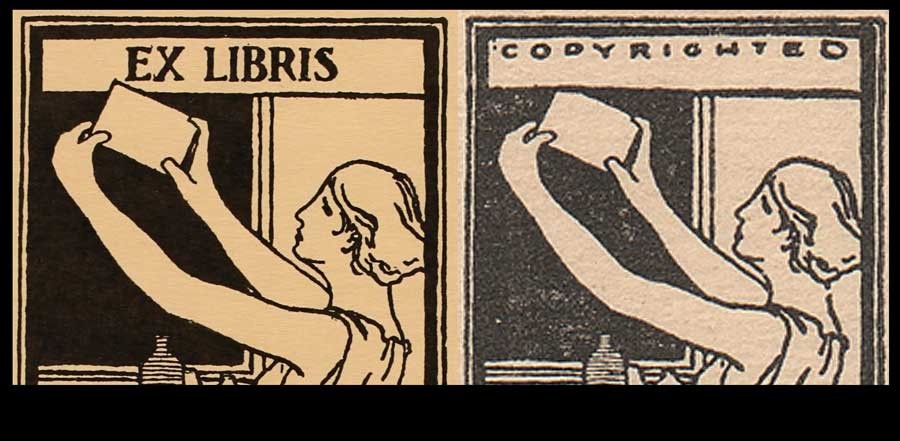 Details: Harvey Ellis: 1897: wood engraving: Ex Libris bookplate and Copyright label for American amateur photographer John Eignas Dumont : Left: bookplate: 9.4 x 4.1 cm: Jensen Tusch Collection- Frederikshavn Kunstmuseum & Exlibrissamling- Denmark: Right: copyright label: 3.4 x 1.3 cm | 7.0 x 4.5 cm : from: PhotoSeed Archive
Details: Harvey Ellis: 1897: wood engraving: Ex Libris bookplate and Copyright label for American amateur photographer John Eignas Dumont : Left: bookplate: 9.4 x 4.1 cm: Jensen Tusch Collection- Frederikshavn Kunstmuseum & Exlibrissamling- Denmark: Right: copyright label: 3.4 x 1.3 cm | 7.0 x 4.5 cm : from: PhotoSeed Archive
In 1899, the original bookplate was described in the pages of the London Journal of the Ex Libris Society:
DUMONT BOOK-PLATES.
By the kindness of a member we are enabled to give an illustration of the book-plate of Mr. John E. Dumont, of Rochester, N.Y., designed by Mr. Harvey Ellis, of the same city. Mr. Dumont is a leading photographer in America, and his works are well known in England. The plate represents the genius of photography surrounded by the accessories of the “dark room.” Mr. Ellis, the designer, is a prominent architect and a water-colour artist of repute. The plate, here given, is graceful in design and execution. (p. 128)
The friendship between Dumont and Ellis extended to 1903. Now serving as president of the Rochester Camera Club, (founded 1889) Dumont was joined by Ellis and future American Photo-Secession member and club member Albert Boursalt while acting as judges for the club’s inaugural photographic exhibition in the newly erected Eastman Building on the campus of the Mechanics Institute. (which became RIT) From March 30 to April 11, over 200 framed photographs were displayed in a building made possible by Rochester philanthropist and Kodak head George Eastman. An account of the exhibition was published, along with the role of Ellis as judge, in the May, 1903 issue of the American Amateur Photographer. An excerpt:
It is stated by Mr. Dumont, who is most familiar with all of the photographic exhibits ever held here, that this of the Rochester Camera Club is by far the best, largest and most meritorious of any ever held in Rochester. Harvey Ellis, whose ability as an art critic is recognized by all, says that there are just as good pictures shown by the local exhibitions as any from out of the city, and that more than one half of the pictures hung are as good as those shown in any of the salons in the country, not excepting New York and Philadelphia, which rank among the highest in merit. (pp. 223-24)
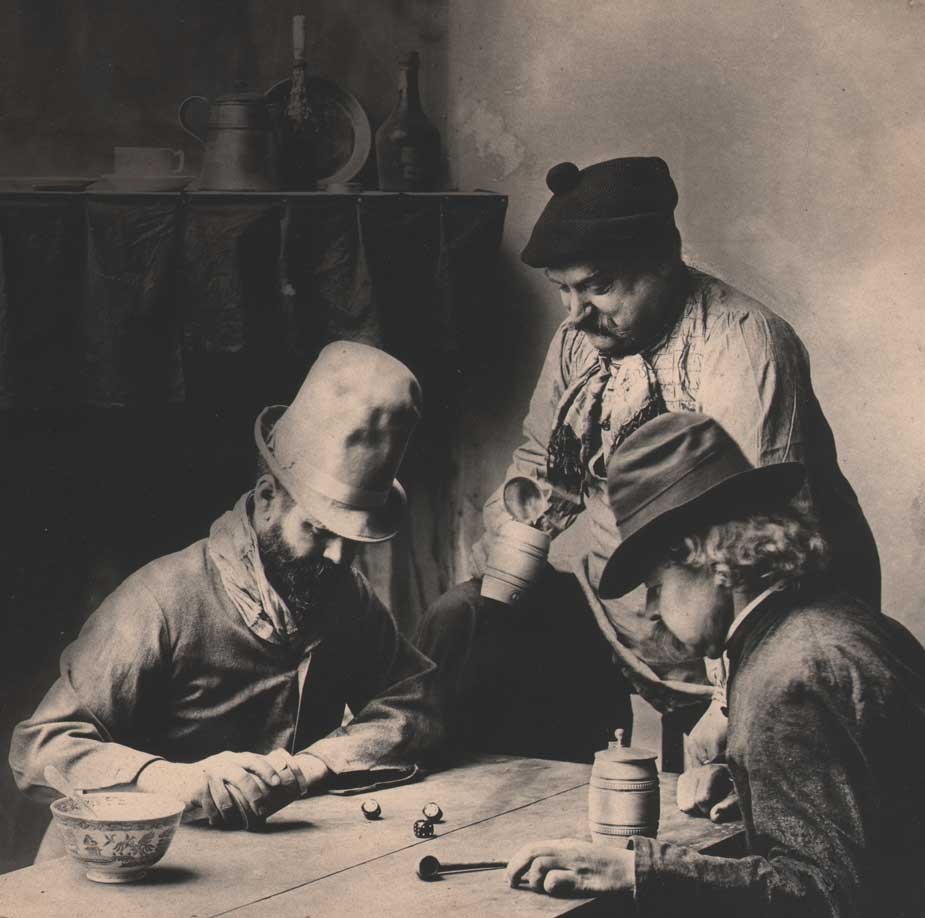 Detail: "The Dice Players": 1891: print ca. 1897 or later: John E. Dumont: carbon print: 29.2 x 25.1 cm (flush mounted to board) : This classic genre photograph by Dumont showing a group of men playing dice (possibly the con game "chuck-a-luck") was first shown in the annual exhibition of the Royal Photographic Society in 1891 and further earned him a gold medal in another contest the same year sponsored by the English journal the Amateur Photographer. From: PhotoSeed Archive
Detail: "The Dice Players": 1891: print ca. 1897 or later: John E. Dumont: carbon print: 29.2 x 25.1 cm (flush mounted to board) : This classic genre photograph by Dumont showing a group of men playing dice (possibly the con game "chuck-a-luck") was first shown in the annual exhibition of the Royal Photographic Society in 1891 and further earned him a gold medal in another contest the same year sponsored by the English journal the Amateur Photographer. From: PhotoSeed Archive
But what immediately followed in the new Eastman Building from April 15-25, 1903: an “Exhibition of Art Craftsmanship”, featuring work from Gustav Stickley’s Craftsman Workshops, (1.) would turn out to be more significant in the overall advancement of the American Arts and Crafts movement compared to the photographic exhibition. A motivating factor perhaps? As it turned out, Harvey Ellis organized the Craftsman show, joining the Stickley firm a month later where he finished a remarkable career.
1. Historical Background: R.I.T. online resource accessed Nov., 2014: “In 1902 the Department of Decorative Arts and Crafts was established at Mechanics Institute under the leadership of Theodore Hanford Pond. An “Exhibition of Art Craftsmanship”, featuring the work of Gustav Stickley’s Craftsman Workshops, was presented in the Mechanics Institute’s Eastman Building, 15-25 April 1903.”
Witching You the Best
Posted October 2014 in New Additions, Significant Photographs
This spooky season. For more on this photograph with a short overview on the pictorial work of Maine resident Bertrand H. Wentworth, proceed here.
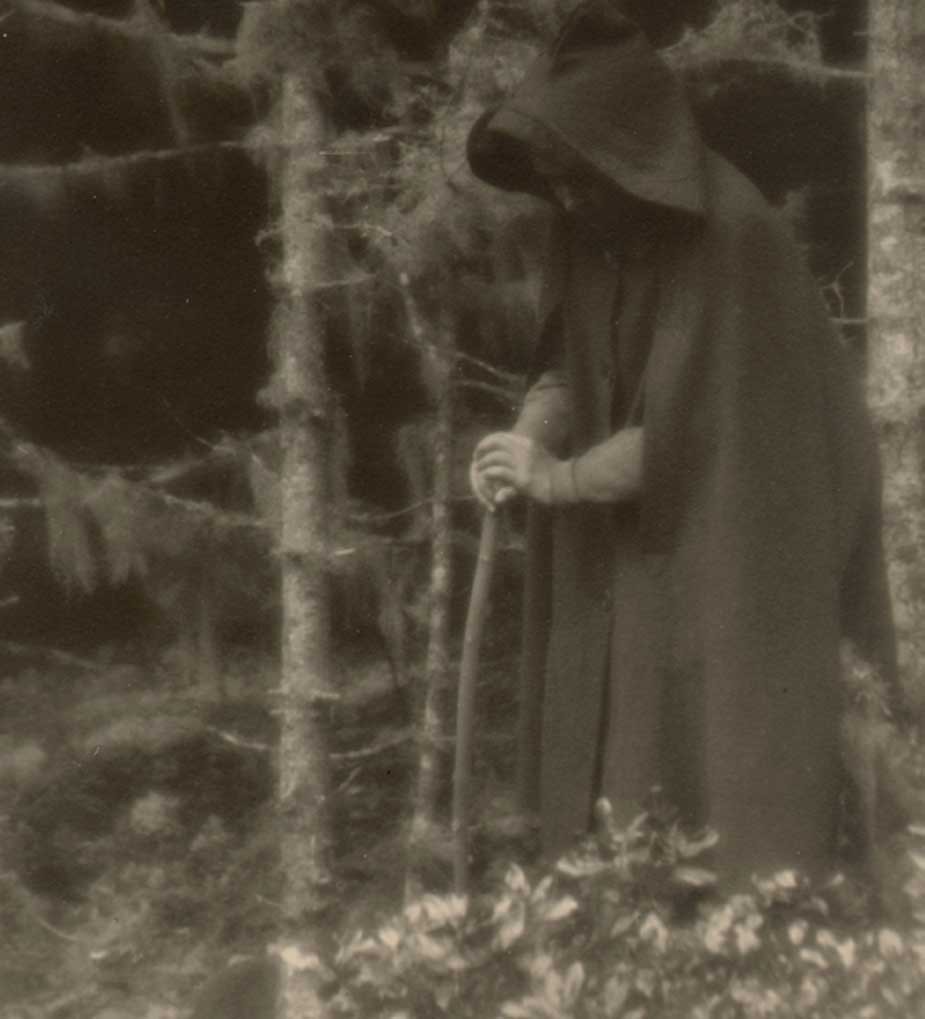 Detail: Bertrand H. Wentworth: American: "Witches' Wood" : (34.9 x 27.1 cm) : vintage gelatin silver print: ca. 1915-20. Perhaps showing the photographer himself dressed as a witch, locations used by Wentworth for his photographs were described in the Oct., 1919 issue of The American Magazine of Art: "The sea, the pine woods, winter landscapes, he has made his specialty, and the majority of his themes he has found in the vicinity of his home at Gardiner, Maine." from: PhotoSeed Archive
Detail: Bertrand H. Wentworth: American: "Witches' Wood" : (34.9 x 27.1 cm) : vintage gelatin silver print: ca. 1915-20. Perhaps showing the photographer himself dressed as a witch, locations used by Wentworth for his photographs were described in the Oct., 1919 issue of The American Magazine of Art: "The sea, the pine woods, winter landscapes, he has made his specialty, and the majority of his themes he has found in the vicinity of his home at Gardiner, Maine." from: PhotoSeed ArchiveBeauty, Underwater
Posted October 2014 in History of Photography, New Additions, Scientific Photography, Significant Photographs
With Autumn upon us in the more seasonal regions of the United States, a remembrance, particularly if we are young, of the joys of cooling off in the lakes, ponds, and rivers of our youth.
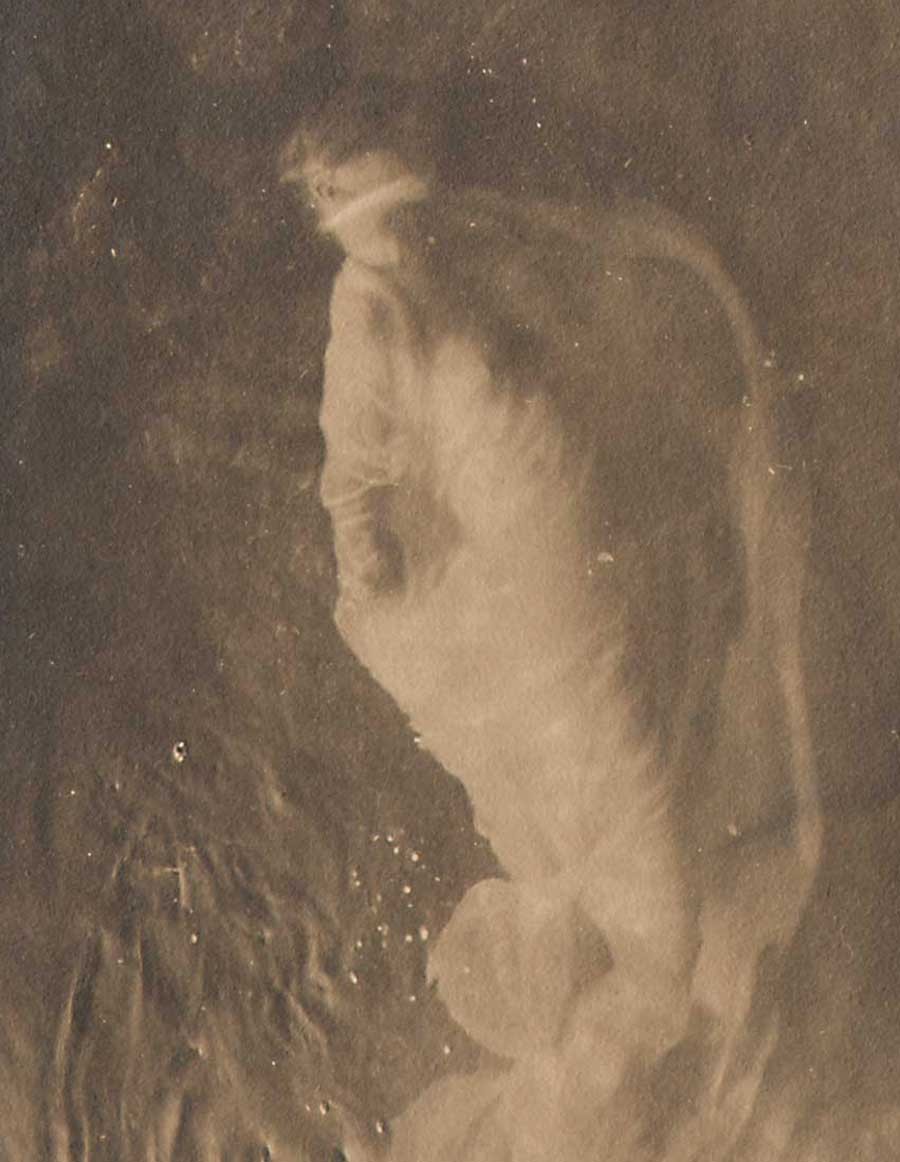 Detail: Gelatin silver print: "Mermaid Study : Ki-lo-des-ka": ca. 1914 or before: by Charlotte Vetter Gulick: image: 7.1 x 9.2 cm: mount: 16.7 x 22.7 cm. Subject shows Katharine "Kitty" Gulick swimming underwater at Camp Wohelo in Maine. from: PhotoSeed Archive
Detail: Gelatin silver print: "Mermaid Study : Ki-lo-des-ka": ca. 1914 or before: by Charlotte Vetter Gulick: image: 7.1 x 9.2 cm: mount: 16.7 x 22.7 cm. Subject shows Katharine "Kitty" Gulick swimming underwater at Camp Wohelo in Maine. from: PhotoSeed Archive
Memories made all the more indelible if we ever had the opportunity to attend summer camp.
So lets go further and think about taking a photograph of someone underwater. Not a photo taken with a camera underwater, a remarkable feat in itself accomplished beginning in 1893 by the Frenchman Louis Boutan, (1.) but from the outside looking in.
Before researching a series of photographs recently acquired for this archive showing a young woman swimming underwater, I would have thought no big deal- perhaps they were rare but could the subject matter actually be unique? After all, they were first published for a mass audience in Everybody’s Magazine in the U.S. in August of 1914, with the author exclaiming them to be “remarkable photographs…taken under conditions not easily duplicated, and have aroused great interest among artists and others who have seen the originals.” (2.)
No doubt other examples of this activity exist in the form of vintage photographs. Snapshots perhaps-but ones where actual intent existed in order to show the beauty of the human figure swimming underwater? Before or perhaps a decade or two after 1914? Somehow I doubt it. ✻
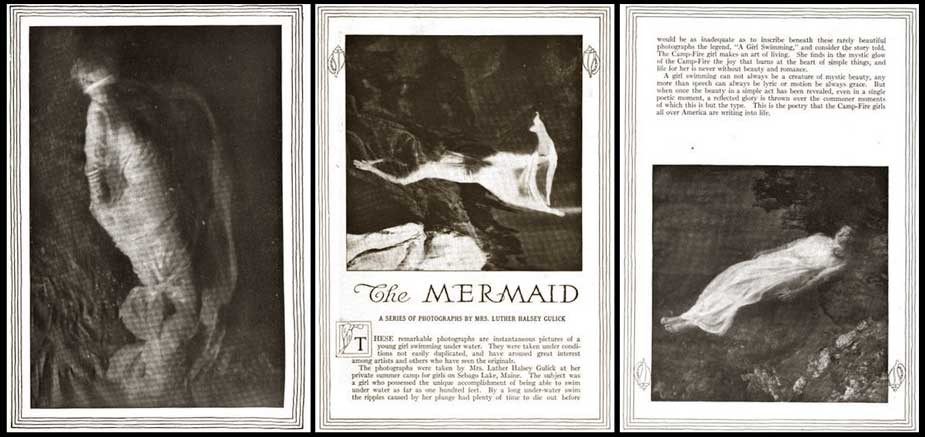 Three individual halftone and letterpress page spreads showing mermaid "Ki-lo-des-ka" (Katharine "Kitty" Gulick) swimming and lying submerged underwater: from: Everybody’s Magazine: New York: August, 1914: pp. 225-232
Three individual halftone and letterpress page spreads showing mermaid "Ki-lo-des-ka" (Katharine "Kitty" Gulick) swimming and lying submerged underwater: from: Everybody’s Magazine: New York: August, 1914: pp. 225-232
With a bit of research, I not only discovered the subject of the “mermaid” doing the swimming in the photos: Katharine “Kitty” Gulick, (1895-1968) but the remarkable story behind the amateur photographer who took them: her mother Charlotte Vetter Gulick. (1865-1928) Taken at Wohelo girls summer camp on the shore of Sebago Lake in Raymond, Maine, a camp founded in 1907 by Gulick and husband Luther Halsey Gulick (1865-1918) that is still going strong today, the following article from Everybody’s explains how these remarkable photos were taken and provides guiding principals behind the Camp Fire Girl movement founded by the photographer herself.
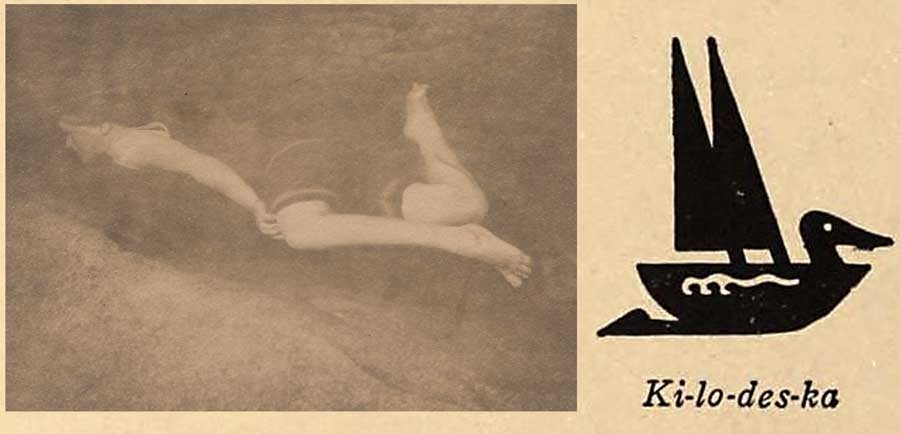 inset: detail: Gelatin silver print: "Mermaid Study : Ki-lo-des-ka" ca. 1914 or before: by Charlotte Vetter Gulick: image: 8.1 x 10.5 cm: mount: 16.8 x 23.2 cm: This was an early effort showing "Kitty" wearing a dark-colored bathing-suit "which was too nearly the tone of the rocks to give definition" before the garment was substituted for "a flowing garment of cheese-cloth" which showed up much better against the darkness of the water.: from: PhotoSeed Archive. Background: Camp Wohelo Indian symbol for "Ki-lo-des-ka" aka: "Water-bird": from 1915 volume by Ethel Rogers: "Sebago-Wohelo Camp Fire Girls"
inset: detail: Gelatin silver print: "Mermaid Study : Ki-lo-des-ka" ca. 1914 or before: by Charlotte Vetter Gulick: image: 8.1 x 10.5 cm: mount: 16.8 x 23.2 cm: This was an early effort showing "Kitty" wearing a dark-colored bathing-suit "which was too nearly the tone of the rocks to give definition" before the garment was substituted for "a flowing garment of cheese-cloth" which showed up much better against the darkness of the water.: from: PhotoSeed Archive. Background: Camp Wohelo Indian symbol for "Ki-lo-des-ka" aka: "Water-bird": from 1915 volume by Ethel Rogers: "Sebago-Wohelo Camp Fire Girls"
Illustrating the article were eight photographs of Wohelo camper “Ki-lo-des-ka”, or “Water-bird”, the aforementioned “Kitty” Gulick, with several of the originals formerly owned by her appearing with this post:
The Mermaid
A SERIES OF PHOTOGRAPHS BY MRS. LUTHER HALSEY GULICK
THESE remarkable photographs are instantaneous pictures of a young girl swimming under water. They were taken under conditions not easily duplicated, and have aroused great interest among artists and others who have seen the originals. The photographs were taken by Mrs. Luther Halsey Gulick at her private summer camp for girls on Sebago Lake, Maine. The subject was a girl who possessed the unique accomplishment of being able to swim under water as far as one hundred feet. By a long under-water swim the ripples caused by her plunge had plenty of time to die out before she passed the rock on which Mrs. Gulick stood with the camera.
The experiments were made on a brilliantly clear day. The water also was extraordinarily clear and the swimmer passed the camera’s field two or three feet below the surface. The final clue to success was found when a flowing garment of cheese-cloth was substituted for the dark-colored bathing-suit, which was too nearly the tone of the rocks to give definition. Both the figure and the draperies, under the equalizing buoyancy of the water, give a rare representation of poise, as they are entirely unaffected by the force of gravity.
How far short this description fails of conveying the art value of the photographs, their rhythm of line and beauty of form and tone, is significantly obvious; for in this margin of appeal to the imagination lies the motive that produced the pictures. They were taken at the birthplace of the Camp-Fire idea of which Mrs. Gulick is one of the chief sponsors.
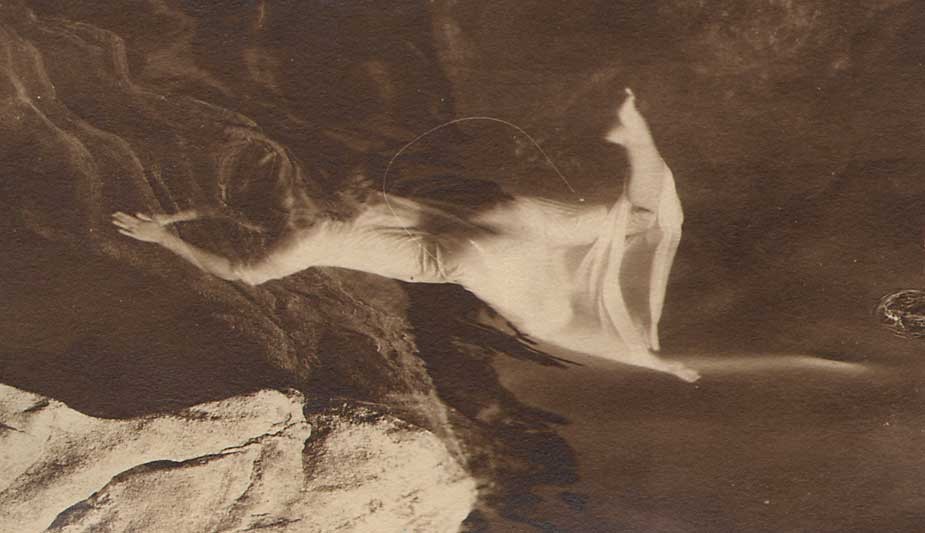 Detail: Gelatin silver or Bromide print: "Mermaid Swimming" ("Ki-lo-des-ka") ca. 1914 or before: by Charlotte Vetter Gulick: image: 8.7 x 11.2 cm: mount: 16.5 x 22.9 cm: reproduced as opening photo for article "The Mermaid" A SERIES OF PHOTOGRAPHS BY MRS. LUTHER HALSEY GULICK: in Everybody’s Magazine: New York: August, 1914: p. 225: note: hair at center of frame result of negligence from contact-printing from original negative. from: PhotoSeed Archive
Detail: Gelatin silver or Bromide print: "Mermaid Swimming" ("Ki-lo-des-ka") ca. 1914 or before: by Charlotte Vetter Gulick: image: 8.7 x 11.2 cm: mount: 16.5 x 22.9 cm: reproduced as opening photo for article "The Mermaid" A SERIES OF PHOTOGRAPHS BY MRS. LUTHER HALSEY GULICK: in Everybody’s Magazine: New York: August, 1914: p. 225: note: hair at center of frame result of negligence from contact-printing from original negative. from: PhotoSeed Archive
The photographs are a suggestive interpretation of the first law of the Camp-Fire, “Seek beauty;” a revelation of the poetic side of one of the simple, wholesome, normal acts of life. This is the principle, full of possibilities yet undeveloped, upon which the Camp-Fire ceremonial and symbolism are based.
The first ideal of the Camp-Fire girl is the development of a well proportioned physique; a body under perfect control and responsive to every call of the spirit within. Her other ideals include an all-around training in the art of home-keeping in the modern sense, which involves a knowledge of community conditions as well as of the simple processes of home activity. This points to the further ideal of patriotism in the sense of loyalty to country, to church, to humanity, and of service in its broadest meaning.
But to hold forth these aims and say “These are the Camp-Fire” would be as inadequate as to inscribe beneath these rarely beautiful photographs the legend, “A Girl Swimming,” and consider the story told. The Camp-Fire girl makes an art of living. She finds in the mystic glow of the Camp-Fire the joy that burns at the heart of simple things, and life for her is never without beauty and romance.
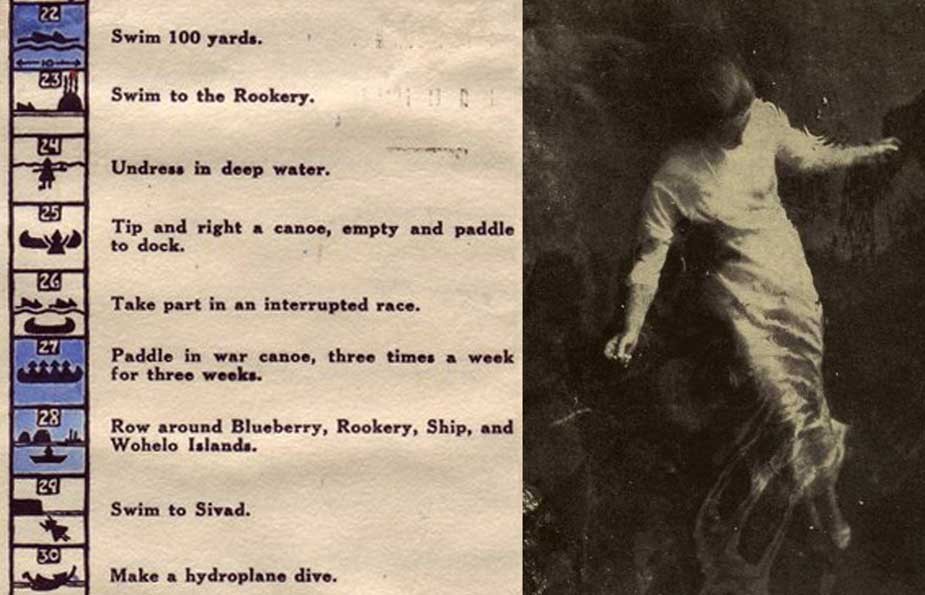 Left: example of Camp Wohelo water-related challenge symbol badges from 1920 Wohelo camp yearbook: courtesy: Gulick Family. Right: detail: full-page halftone: "Ki-lo-des-ka swimming under water" : from 1915 volume by Ethel Rogers: "Sebago-Wohelo Camp Fire Girls"
Left: example of Camp Wohelo water-related challenge symbol badges from 1920 Wohelo camp yearbook: courtesy: Gulick Family. Right: detail: full-page halftone: "Ki-lo-des-ka swimming under water" : from 1915 volume by Ethel Rogers: "Sebago-Wohelo Camp Fire Girls"
A girl swimming can not always be a creature of mystic beauty, any more than speech can always be lyric or motion be always grace. But when once the beauty in a simple act has been revealed, even in a single poetic moment, a reflected glory is thrown over the commoner moments of which this is but the type. This is the poetry that the Camp-Fire girls all over America are writing into life. (3.)
Camp Fire Girls, Basket Ball and More
Born Emma L. Vetter on Dec. 12, 1865 in Oberlin, Ohio to missionary parents, (4.) Charlotte “Lottie” Gulick was educated in Kansas public schools and undertook her secondary education at Washburn College (now Washburn University) in Topeka, Kansas doing college preparatory work. She then matriculated and earned a bachelor of arts degree from Drury College in Springfield, MO. (5.) It was at Drury that she met Luther Halsey Gulick , (1865-1918) whom she married in 1887.
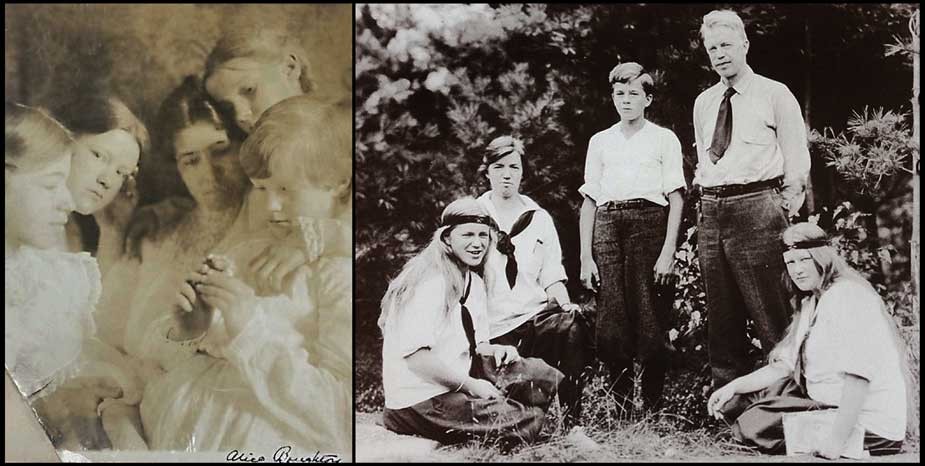 Left: photographer Charlotte Vetter Gulick is at center surrounded by her four daughters. Photograph by Alice Boughton ca. 1900. Katharine (Ki-lo-des-ka) is believed to be at right holding a flower. Reproduced later as an engraving in a New York Times article profiling the new Campfire Girls of America organization: "Girls take up the Boy Scout Idea and Band Together" (March 17, 1912) (private collection) Right: detail: members of the Gulick family from a photograph most likely taken by Charlotte Gulick around 1911. From left to right: Katharine "Kitty" Gulick (Curtis) (1895-1968); Frances "Franta" Gulick(1891-1936); Halsey Gulick; Dr. Luther Halsey Gulick (Timanous-1865-1918); Louise Gulick. (1888-1941): courtesy: Gulick Family
Left: photographer Charlotte Vetter Gulick is at center surrounded by her four daughters. Photograph by Alice Boughton ca. 1900. Katharine (Ki-lo-des-ka) is believed to be at right holding a flower. Reproduced later as an engraving in a New York Times article profiling the new Campfire Girls of America organization: "Girls take up the Boy Scout Idea and Band Together" (March 17, 1912) (private collection) Right: detail: members of the Gulick family from a photograph most likely taken by Charlotte Gulick around 1911. From left to right: Katharine "Kitty" Gulick (Curtis) (1895-1968); Frances "Franta" Gulick(1891-1936); Halsey Gulick; Dr. Luther Halsey Gulick (Timanous-1865-1918); Louise Gulick. (1888-1941): courtesy: Gulick Family
A strong advocate in the promotion of physical eduction as well as an organizer and author in his professional life, Dr. Luther Halsey Gulick also came from a missionary family, his father being missionary physician Luther Halsey Gulick Sr. (1828–1891) Receiving his medical degree from New York University in 1889, Dr. Gulick is perhaps best remembered today for his role in the development of the game of basketball, although this is but an interesting side story of a remarkable life. In 1891, while superintendent of the physical education department at the International YMCA Training School in Springfield, MA., (now Springfield College) he became the catalyst and inspiration for colleague James Naismith to first draw up rules for the new game of “Basket Ball”, with a peach basket nailed above the inside of a gymnasium playing court serving as the goal. His beliefs, as embodied in a poster issued after his death, were in the
”unity of body, mind and spirit, and in an education which includes all three. He devoted his life to establishing this ideal, by emphasizing the social and ethical values of physical exercise, especially through play and recreation.”
While at the YMCA, he was also responsible for designing the triangular logo which represented the YMCA philosophy of Mind, Body and Spirit. (6.)
Summer camp was an activity the Gulicks thrived on and made a lifestyle out of. Beginning in 1887, a year before their first child Louise was born, they established a camp on the shores of the Thames River in Gales Ferry CT. Co-educational, with the couples friends as well as extended Gulick family members acting as counselors to their own children and others, (7.) it operated for 20 years. In order to share what was learned to a larger audience of girls, the couple then established Camp Wohelo on Sebago Lake in 1907. An acronym comprised of the three virtues of work, health, and love, Wohelo was embodied from the start as outlined in 1915 by Charlotte Vetter Gulick:
I believe deeply and earnestly that spiritual health and development is a direct corollary of bodily vigor and control; that the joy that comes from the exercise of efficient muscles has its counterpart in the soul; that to exercise the one is to exercise the other.
Upon that rock has Wohelo been built, and its use of symbols is, perhaps, more than anything else, a working and ever-present declaration of the spiritual values inherent in all the humblest phases of our everyday life in the world. (8.)
 Detail: "Mermaid Study : Submerged": Gelatin silver print: ca. 1914 or before: by Charlotte Vetter Gulick: image: 8.4 x 10.8 cm: mount: 16.7 x 22.7 cm. : reproduced as final photo for article "The Mermaid" A SERIES OF PHOTOGRAPHS BY MRS. LUTHER HALSEY GULICK: in Everybody’s Magazine: New York: August, 1914: p. 232: from: PhotoSeed Archive
Detail: "Mermaid Study : Submerged": Gelatin silver print: ca. 1914 or before: by Charlotte Vetter Gulick: image: 8.4 x 10.8 cm: mount: 16.7 x 22.7 cm. : reproduced as final photo for article "The Mermaid" A SERIES OF PHOTOGRAPHS BY MRS. LUTHER HALSEY GULICK: in Everybody’s Magazine: New York: August, 1914: p. 232: from: PhotoSeed Archive
Five years before this philosophy was written, in 1910, Charlotte Gulick, known by her symbolic Indian name at the Wohelo camp as Hiiteni, which translated to “Life, more life”, came up with the idea for the Camp Fire Girls movement. An organization for girls much as the Boy Scouts of America was structured for boys, and coincidentally founded the same year, Camp Fire Girls promoted all the values she and her husband had already been teaching at their earlier camp at Gales Ferry and at Wohelo:
”The idea originated in the mind of Mrs. Gulick, and was at once indorsed by Dr. Gulick, who believes it to be logical and necessary to proper development of girls amid the changing conditions of our National life.” (9.)
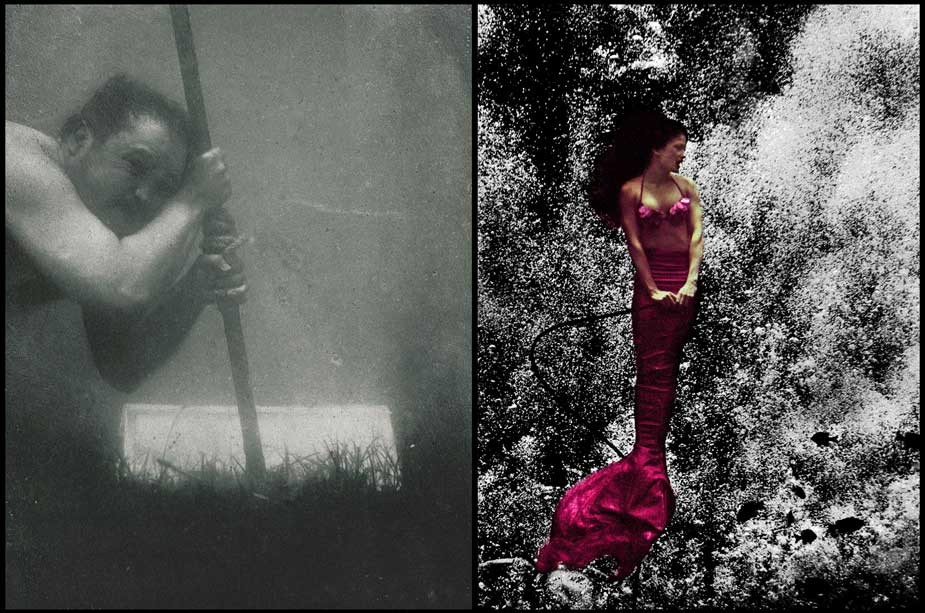 Left: detail: photo by "David": title: "Portrait Instantané D'un Plongeur" ("Instant Portrait of a Diver") : photogravure plate XI by Paul Dujardin showing French underwater photography pioneer Louis Marie-Auguste Boutan (1859-1934) holding himself steady underwater: from: 1900 volume "La Photographie Sous-Marine et Les Progres de La Photographie" (The Progress of Underwater Photography) (between pp. 210-211) : Gallica: National Library of France online resource. Right: a modern-day mermaid: Nicole Marino plays the starring role in "The Little Mermaid" at Florida's Weeki Wachee Springs Waterpark. In 1947, former Navy frogman Newton Perry conceived of the idea of using an air hose and perfected "hose breathing" here. Culturally, mermaids are a tourist attraction, and have entered the popular imagination through films like "The Incredible Mr. Limpet" starring Don Knotts. (1964): 1999 photo by David Spencer/The Palm Beach Post
Left: detail: photo by "David": title: "Portrait Instantané D'un Plongeur" ("Instant Portrait of a Diver") : photogravure plate XI by Paul Dujardin showing French underwater photography pioneer Louis Marie-Auguste Boutan (1859-1934) holding himself steady underwater: from: 1900 volume "La Photographie Sous-Marine et Les Progres de La Photographie" (The Progress of Underwater Photography) (between pp. 210-211) : Gallica: National Library of France online resource. Right: a modern-day mermaid: Nicole Marino plays the starring role in "The Little Mermaid" at Florida's Weeki Wachee Springs Waterpark. In 1947, former Navy frogman Newton Perry conceived of the idea of using an air hose and perfected "hose breathing" here. Culturally, mermaids are a tourist attraction, and have entered the popular imagination through films like "The Incredible Mr. Limpet" starring Don Knotts. (1964): 1999 photo by David Spencer/The Palm Beach Post
Today, the history of the Gulick’s shared virtues of work, health and love continue on in the summer operation of their Maine camps. In a promotional 1919 silent film on Wohelo released a year before women in the United States had the Constitutional protection of the right to vote, these changing conditions of America’s National life for young women were on display. Seated in teams of coordinated paddlers in three large over-sized canoes on Lake Sebago, the ideals of resourcefulness in working together shown in the film remains an ideal for young women still valued today.
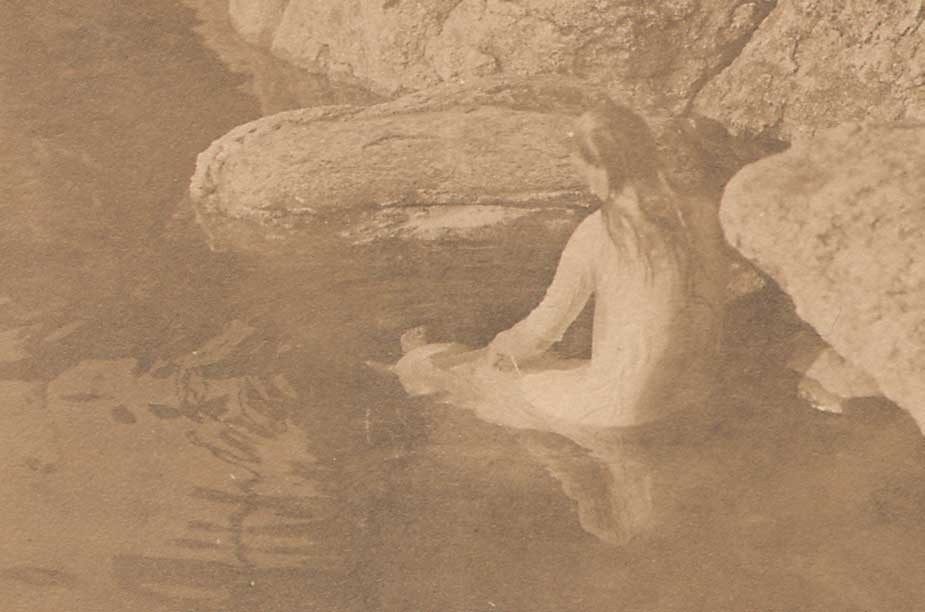 Detail: "Mermaid Sunbathing " ("Kitty" Gulick) : Gelatin silver print: ca. 1914 or before: by Charlotte Vetter Gulick: image: 7.3 x 10.8 cm: mount: 17.0 x 22.5 cm. : In this photo, a figure study of Katharine "Kitty" Gulick by her mother, "Ki-lo-des-ka" sunbathes next to granite boulders on the Sebago Lake shoreline in Maine.: from: PhotoSeed Archive
Detail: "Mermaid Sunbathing " ("Kitty" Gulick) : Gelatin silver print: ca. 1914 or before: by Charlotte Vetter Gulick: image: 7.3 x 10.8 cm: mount: 17.0 x 22.5 cm. : In this photo, a figure study of Katharine "Kitty" Gulick by her mother, "Ki-lo-des-ka" sunbathes next to granite boulders on the Sebago Lake shoreline in Maine.: from: PhotoSeed Archive
Much like these photos of Ki-lo-des-ka the mermaid, “her yellow hair glinting golden in the sunshine” (10.) reveal beauty to us in the physical form, lines from a poem by Ralph Waldo Emerson cited by the amateur photographer Charlotte Gulick after she mastered the art of water diving at the age of 35 brings forth a desire in the human spirit to symbolically enter the depths as well:
”To vision profounder
Man’s spirit must dive.“ (11.)
Notes:
1. Louis Marie-Auguste Boutan. (1859-1934) Boutan used specially-designed underwater camera housings, publishing his research conducted from 1892-1900 for a large audience in the 1900 volume “La Photographie Sous-Marine et Les Progres de La Photographie”. (The Progress of Underwater Photography)
2. from: The Mermaid: in: Everybody’s Magazine: New York: The Ridgway Company Publishers: August, 1914: p. 225
3. Ibid: pp. 225-232
4. 1870 U.S. Census. Gulick changed her name to Charlotte sometime after 1900 but was known as “Lottie”
5. Gulick background: Margaret R. and Dennis S. O’Leary: Adventures at Wohelo Camp - Summer of 1928: 2011: iUniverse: p. 24
6. 1921 poster of Luther Halsey Gulick: Makers of American Ideals poster issued by the National Child Welfare Association: Springfield College Digital online resource accessed Oct., 2014
7. background: Camp Timanous website accessed Oct., 2014. Owned by the Suitor family since the 1930’s, the camp was originally founded by Luther Halsey Gulick in 1917, whose symbolic Indian name Timanous- was “Guiding Spirit”. In the introduction to the 1915 Sebago-Wohelo Camp Fire Girls volume, Charlotte Gulick states as many as 75 people camped together at Gales Ferry before Wohelo was established.
8. excerpt: Introduction: Mrs. Luther Halsey Gulick: Ethel Rogers: Sebago-Wohelo Camp Fire Girls: Battle Creek, MI: Good Health Publishing Company: 1915: pp. 22-23
9. excerpt: Girls Take up the Boy Scout Idea and Band Together: Edward Marshall: in: The New York Times: March 17, 1912
10. Sebago-Wohelo Camp Fire Girls: p. 94
11. Ibid: p. 22
✻ : and of course I’m happy to be corrected
What the Heck? Solved!
Posted June 2014 in New Additions
Update: Solved! See below. Our original post from June, 2014:
Sometimes, scratching your head does make sense. Especially when encountering a photograph such as this. I wish I could elaborate beyond my first instinct, which is that the subject resembles some kind of shrunken head with an extremely bad hair day.
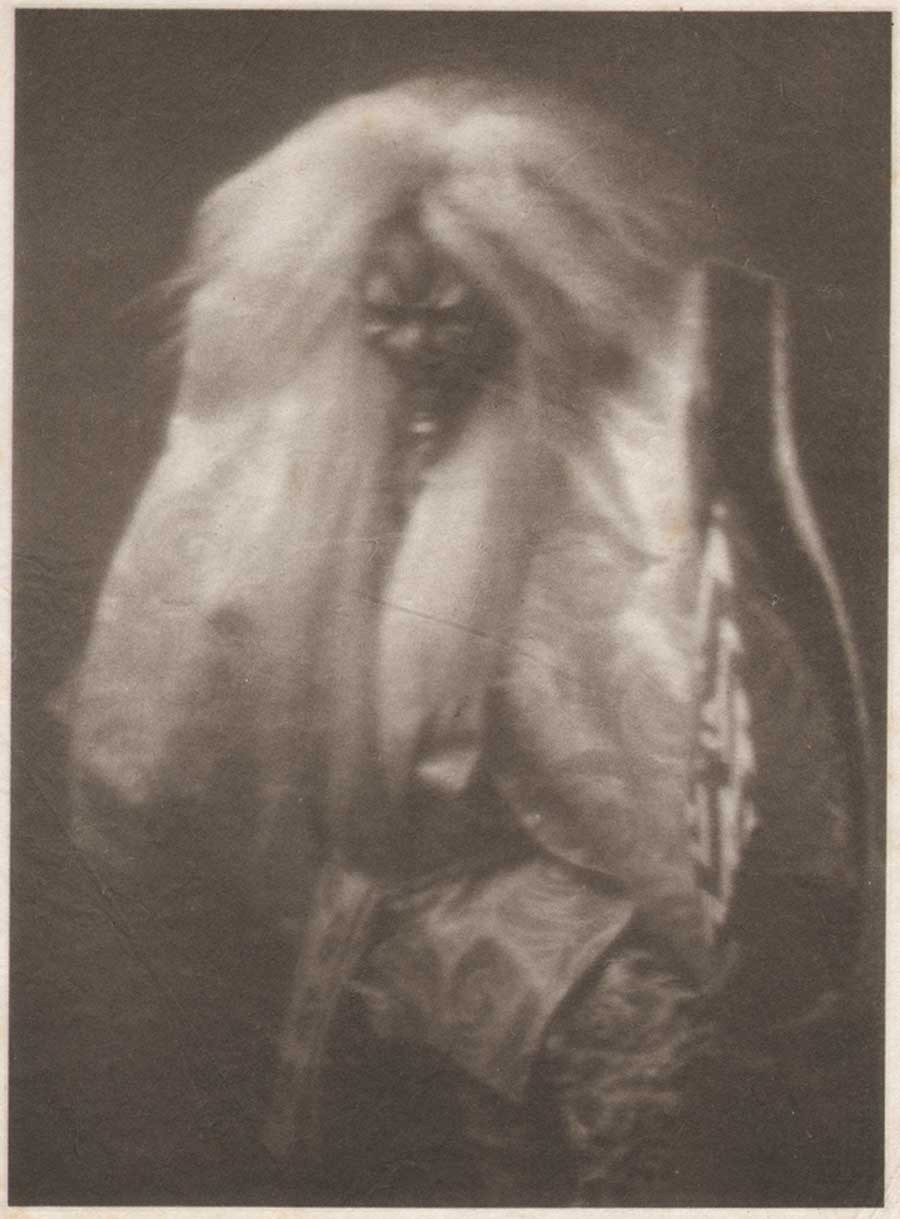 "Asian Mask?": cropped to image margins: (19.6 x 14.4 cm | 27.0 x 19.6 cm) Japanese tissue gravure: 1900-1920: from: PhotoSeed Archive
"Asian Mask?": cropped to image margins: (19.6 x 14.4 cm | 27.0 x 19.6 cm) Japanese tissue gravure: 1900-1920: from: PhotoSeed Archive
However, on close inspection, it might actually appear to be some kind of Asian mask, dressed in what appear to be elaborate silk garments. But these are only guesses. This very fine tissue gravure printed on a thin sheet of Japan laid paper was purchased for this archive from a dealer based in Warwickshire, England in the Fall of 2012. It was purchased at the same time by a lovely pictorialist study that I’ve titled Agnes, which can be seen here.
Does anyone have clues as to the actual subject matter and or author responsible for this mysterious photograph?
Solved! January, 2020. This portrait shows a Japanese Noh dancer. The variant below was published in Photograms of the Year 1918: The Annual Review of the World’s Pictorial Photographic Work. Please see this link for additional details on the photographer.
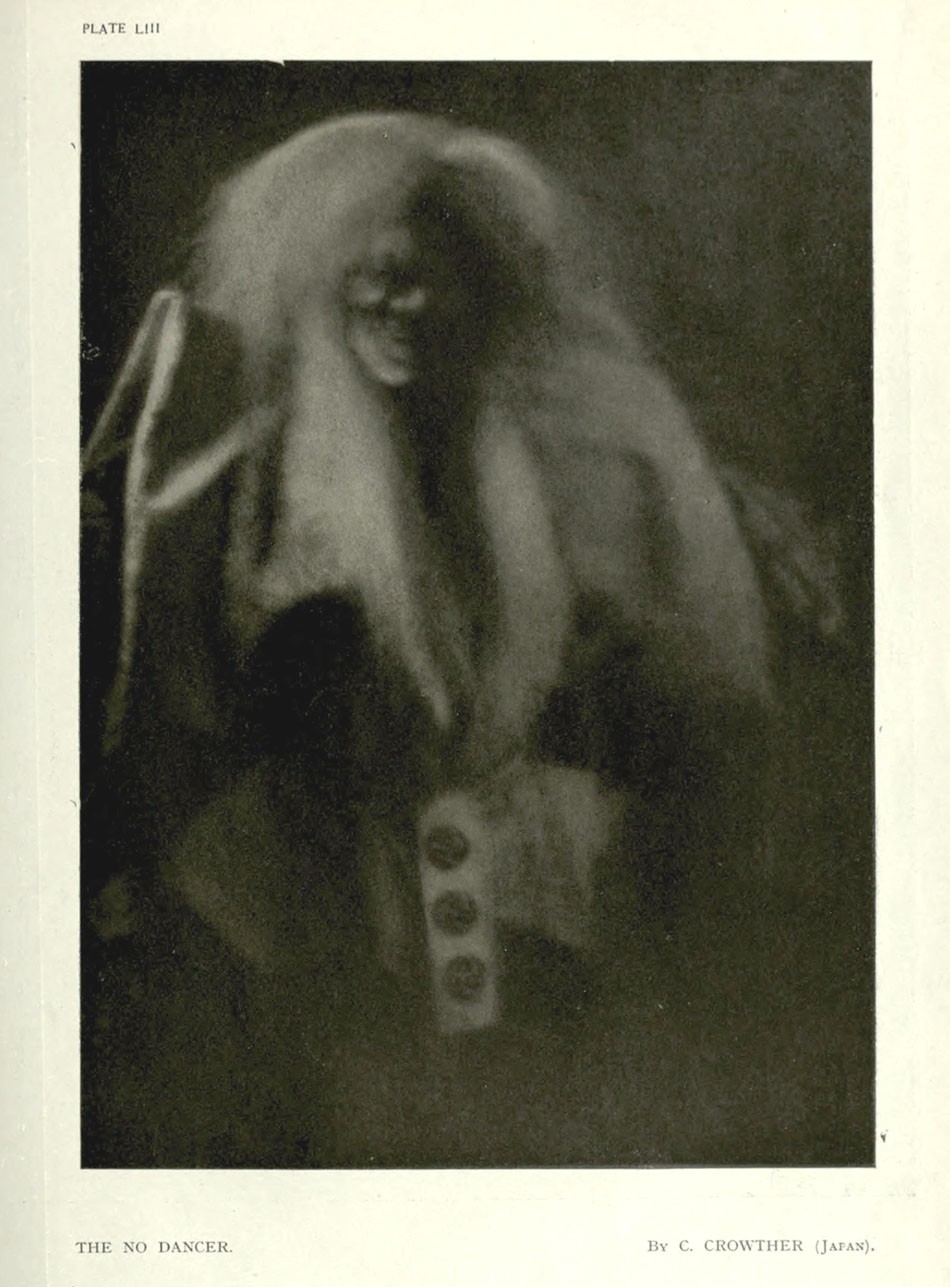 "The No Dancer”, Plate LIII: C. Pollard Crowther- 1859-1941: English. Crowther was living and working in Kobe, Japan when this full-page halftone was published in the photographic annual "Photograms of the Year 1918: The Annual Review of the World's Pictorial Photographic Work"- Edited by F.J. Mortimer, F.R.P.S: London: Iliffe & Sons, Limited. From: HathiTrust digital Library
"The No Dancer”, Plate LIII: C. Pollard Crowther- 1859-1941: English. Crowther was living and working in Kobe, Japan when this full-page halftone was published in the photographic annual "Photograms of the Year 1918: The Annual Review of the World's Pictorial Photographic Work"- Edited by F.J. Mortimer, F.R.P.S: London: Iliffe & Sons, Limited. From: HathiTrust digital Library
Performance, not Results
Posted March 2014 in New Additions, Photography
Besides the obvious: a permanent, for the most part, result in the form of a photograph; the act of taking said photograph could be argued as being just as important. For some, it really is the point.
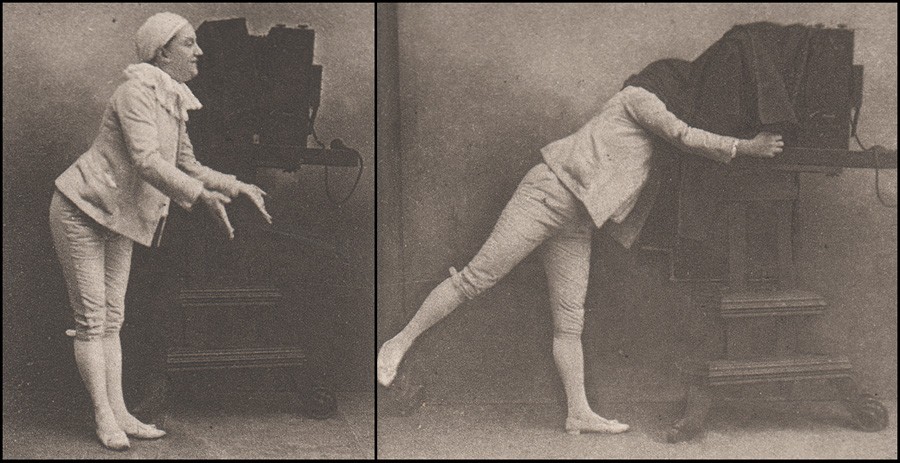 Left: Pantomime clown Pierrot played by French actress Félicia Mallet (1863-1928) introduces himself to subject in the Photography studio. Right: Pierrot steps underneath the dark cloth while focusing the camera. Details-both: (5.7 x 4.3 cm & 5.7 x 5.4 cm) Arthur da Cunha: "Pierrot Photographe": vintage hand-pulled photogravure from March, 1896 issue of the Bulletin du Photo-Club de Paris: PhotoSeed Archive
Left: Pantomime clown Pierrot played by French actress Félicia Mallet (1863-1928) introduces himself to subject in the Photography studio. Right: Pierrot steps underneath the dark cloth while focusing the camera. Details-both: (5.7 x 4.3 cm & 5.7 x 5.4 cm) Arthur da Cunha: "Pierrot Photographe": vintage hand-pulled photogravure from March, 1896 issue of the Bulletin du Photo-Club de Paris: PhotoSeed Archive
Can I take your picture? Why sure. Why would you be interested may I ask? Because…
I find you: insert adjective here. Or don’t ask permission.
Because. No real reason at all, other than it sorta confirms your existence for posterity. So not a bad tradeoff, especially for those who might want to look back, far off in the future, or five minutes from now.
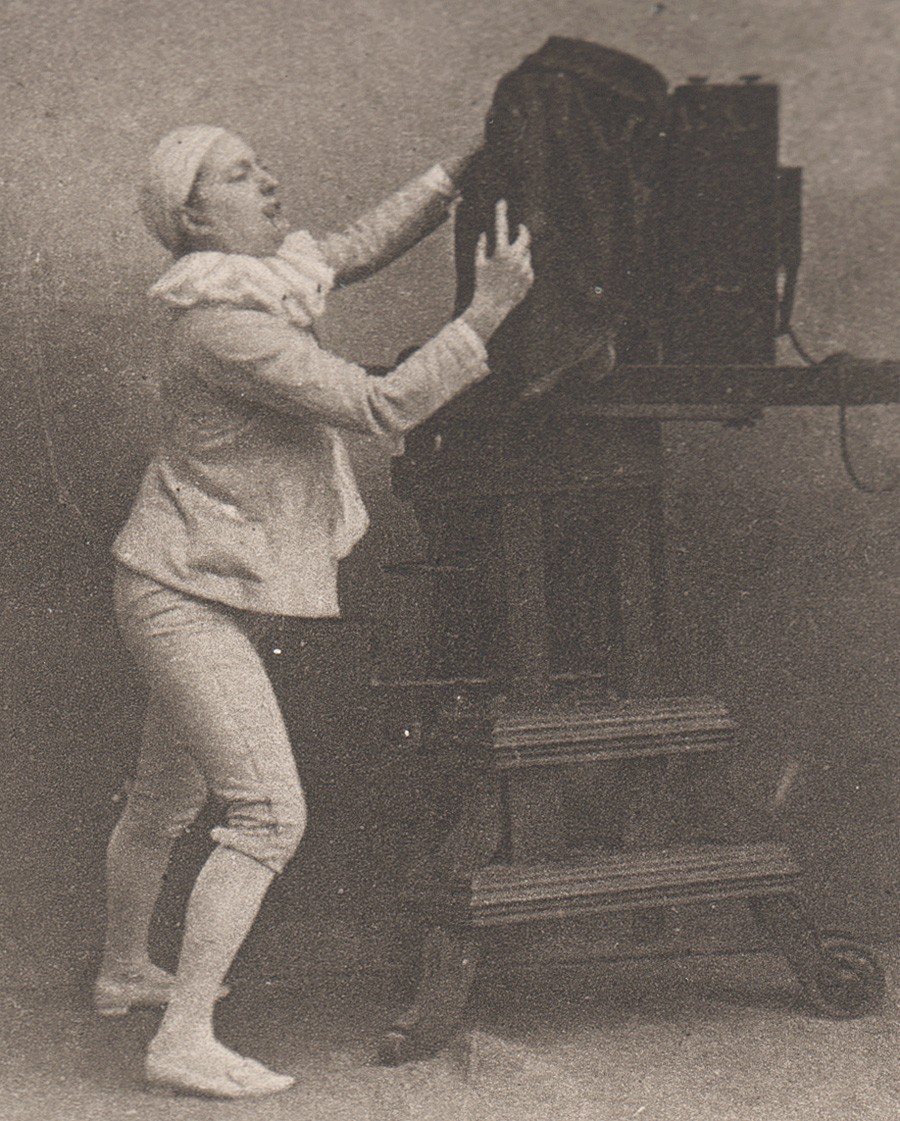 Pantomime clown Pierrot played by French actress Félicia Mallet (1863-1928) places the film back into the rear of the studio camera. Detail: (5.7 x 4.3 cm) Arthur da Cunha: "Pierrot Photographe": vintage hand-pulled photogravure from March, 1896 issue of the Bulletin du Photo-Club de Paris: PhotoSeed Archive
Pantomime clown Pierrot played by French actress Félicia Mallet (1863-1928) places the film back into the rear of the studio camera. Detail: (5.7 x 4.3 cm) Arthur da Cunha: "Pierrot Photographe": vintage hand-pulled photogravure from March, 1896 issue of the Bulletin du Photo-Club de Paris: PhotoSeed Archive
Going back well over a century, this series of photographs is confirmation act has always been wrapped up in art. For proof, observe the capable body language of voiceless French actress Félicia Mallet, (1863–1928) published in 1896 and recently posted. As Pierrot, she was taking on the role modern scholars consider the essence of the artist’s alter-ego. Especially as some might consider: “the famously alienated artist of the nineteenth and early twentieth centuries.” (1.)
 Pantomime clown Pierrot played by French actress Félicia Mallet (1863-1928) instructs subject to be still while preparing to release bulb shutter on studio camera. Detail: (5.7 x 4.3 cm) Arthur da Cunha: "Pierrot Photographe": vintage hand-pulled photogravure from March, 1896 issue of the Bulletin du Photo-Club de Paris: PhotoSeed Archive
Pantomime clown Pierrot played by French actress Félicia Mallet (1863-1928) instructs subject to be still while preparing to release bulb shutter on studio camera. Detail: (5.7 x 4.3 cm) Arthur da Cunha: "Pierrot Photographe": vintage hand-pulled photogravure from March, 1896 issue of the Bulletin du Photo-Club de Paris: PhotoSeed Archive
But the inherently silent results recorded by French photographer Arthur da Cunha here are besides the point. A live performance will always elicit a critic, particularly one on the public stage.
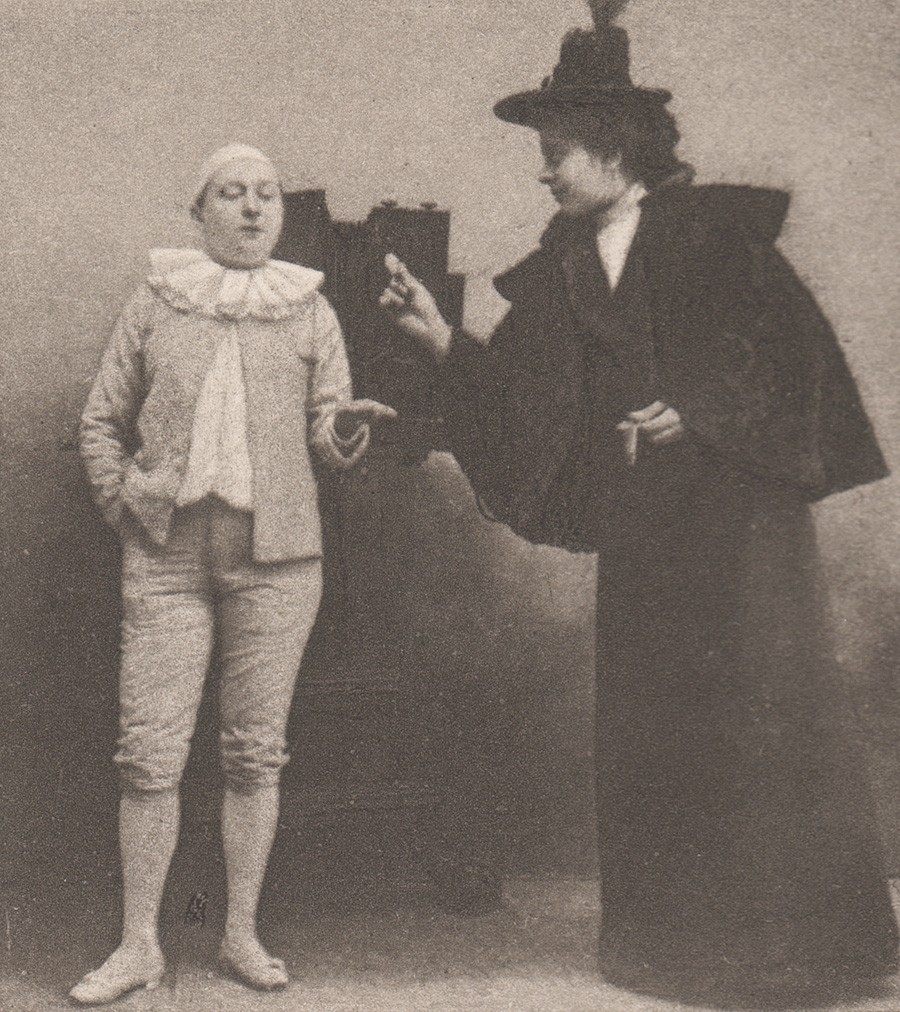 Pantomime clown Pierrot played by French actress Félicia Mallet (1863-1928) holds out hand to receive payment from subject for taking photograph. Detail: (5.7 x 5.4 cm) Arthur da Cunha: "Pierrot Photographe": vintage hand-pulled photogravure from March, 1896 issue of the Bulletin du Photo-Club de Paris: PhotoSeed Archive
Pantomime clown Pierrot played by French actress Félicia Mallet (1863-1928) holds out hand to receive payment from subject for taking photograph. Detail: (5.7 x 5.4 cm) Arthur da Cunha: "Pierrot Photographe": vintage hand-pulled photogravure from March, 1896 issue of the Bulletin du Photo-Club de Paris: PhotoSeed Archive
In a fortunate coincidence, no less an observer than George Bernard Shaw weighed in a year later, his take on Mallet’s performance during the London stage production of A Pierrot’s Life giving readers the opinion her Pierrot was far more believable than one played by (Mrs.) Signora Litini:
The recasting of “A Pierrot’s Life” at the matinees at the Prince of Wales’ Theatre greatly increases and solidifies the attraction of the piece. Felicia Mallet now plays Pierrot; but we can still hang on the upturned nose of the irresistible Litini, who reappears as Fifine. Litini was certainly a charming Pierrot; but the delicate, subtle charm was an intensely feminine one, and only incorporated itself dreamily with the drama in the tender shyness of the first act and the pathos of the last. Litini as a vulgar drunkard and gambler was as fantastically impossible as an angel at a horse-race. Felicia Mallet is much more credible, much more realistic, and therefore much more intelligible — also much less slim, and not quite so youthful. Litini was like a dissolute “La Sylphide”: Mallet is frankly and heartily like a scion of the very smallest bourgeoisie sowing his wild oats. She is a good observer, a smart executant, and a vigorous and sympathetic actress, apparently quite indifferent to romantic charm, and intent only on the dramatic interest, realistic illusion, and comic force of her work. And she avoids the conventional gesture-code of academic Italian pantomime, depending on popularly graphic methods throughout. The result is that the piece is now much fuller of incident, much more exciting in the second act (hitherto the weak point) and much more vivid than before. (2.)
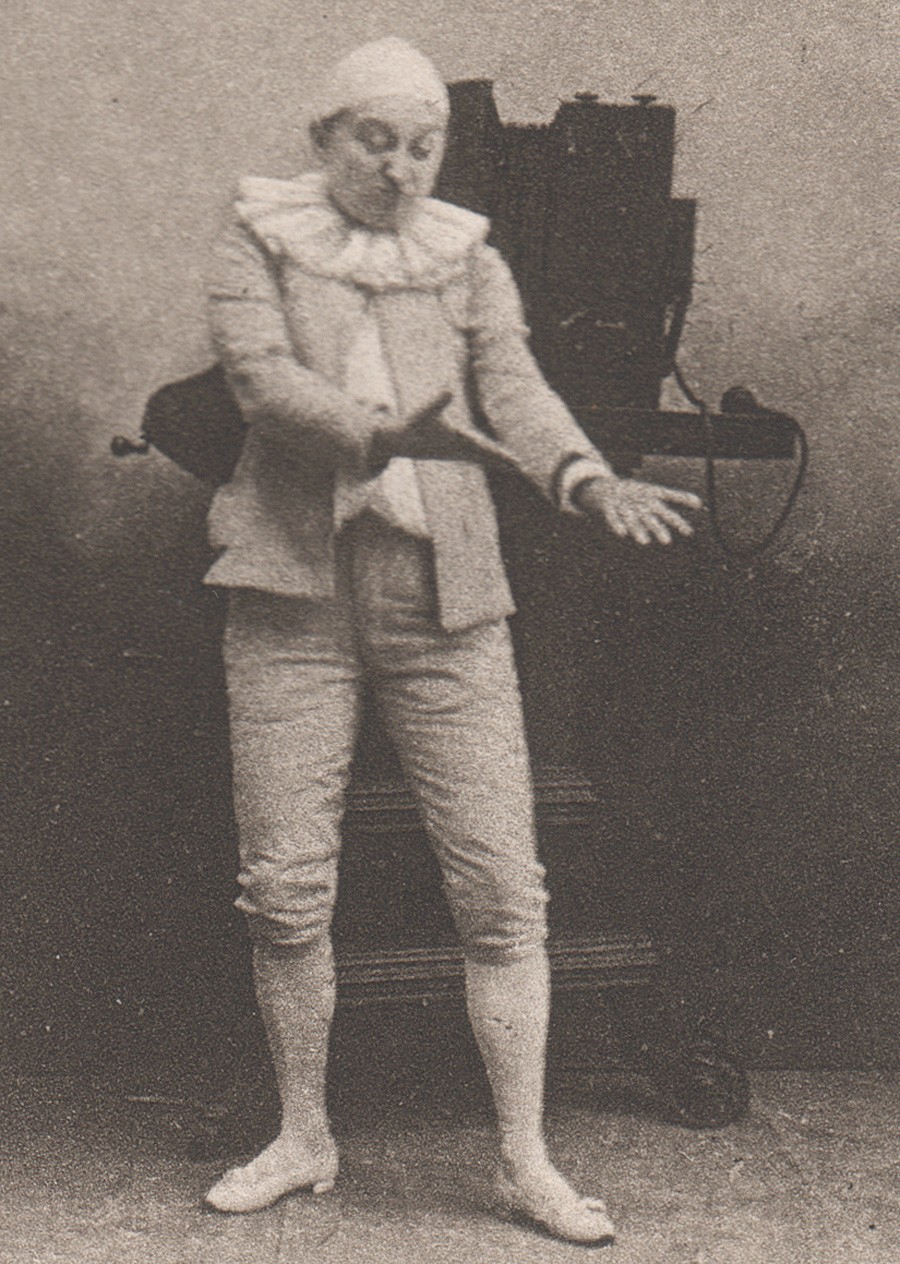 Performance complete. Pantomime clown Pierrot played by French actress Félicia Mallet (1863-1928) acknowledges applause for taking photograph. Detail: (5.7 x 4.3 cm) Arthur da Cunha: "Pierrot Photographe": vintage hand-pulled photogravure from March, 1896 issue of the Bulletin du Photo-Club de Paris: PhotoSeed Archive
Performance complete. Pantomime clown Pierrot played by French actress Félicia Mallet (1863-1928) acknowledges applause for taking photograph. Detail: (5.7 x 4.3 cm) Arthur da Cunha: "Pierrot Photographe": vintage hand-pulled photogravure from March, 1896 issue of the Bulletin du Photo-Club de Paris: PhotoSeed Archive
Notes:
1. Pierrot: see: Wikipedia overview: accessed, March, 2014
2. excerpt: Meredith on Comedy: An Essay on Comedy. By George Meredith. Westminster: Archibald Constable & Co. 1897: from: Dramatic Opinions and Essays by G. Bernard Shaw/(James Huneker): Volume 2: New York: Brentanos: 1906: pp. 225-6